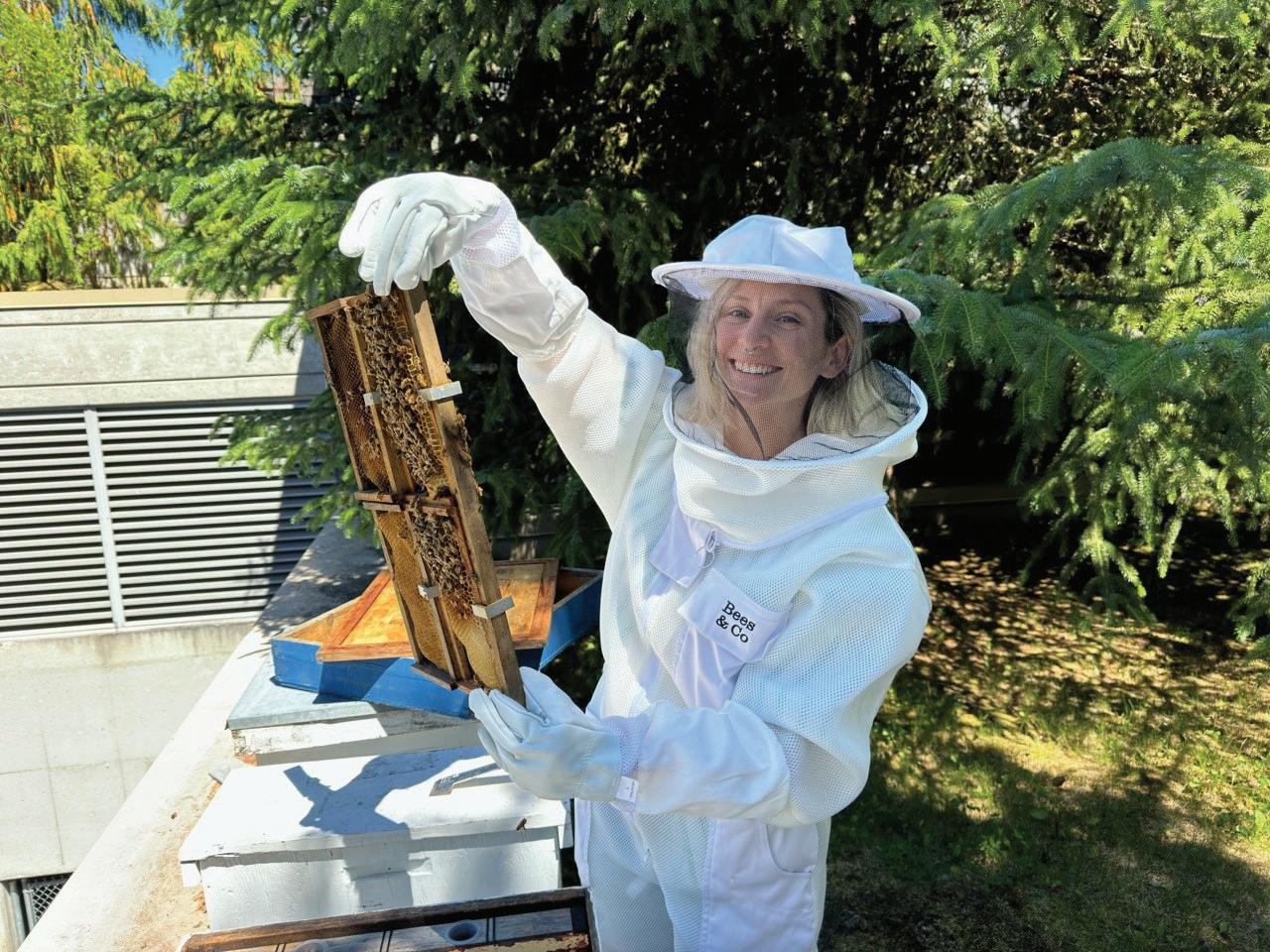






























































A long-awaited agreement will address Canadian mine waste flowing downriver into Montana and Idaho. - By Kylie Mohr / High Country News
06 OPENING REMARKS As summer gets underway in earnest, it’s important to stay vigilant and keep all eyes on the forests, writes editor Braden Dupuis.
08 LETTERS TO THE EDITOR This week’s letter writers have a lot to say about council’s decision not to renew a lease for the Whistler Waldorf School.
11 PIQUE’N YER INTEREST The heat is on in Whistler, and we all need to be ready for a potential wildfire in the resort, writes columnist Andrew Mitchell.
46 MAXED OUT G.D. Maxwell, noted opinion-haver, weighs in on the Whistler Waldorf School drama (with his own personal opinion).
12 SCHOOL’S OUT A wave of Whistler Waldorf School supporters descended on council this week to voice their strong opposition to a decision to end the school’s lease.
15 TRAGIC END A trio of missing mountaineers was found dead this week in Garibaldi Park after an extensive search-and-rescue effort.
26 SOPP STORY Kevin and Jennifer Sopp are being recognized for their nearly three decades coaching and managing local hockey teams.
32 BAYOU BRASS The New Breed Brass Band brings New Orleans to Whistler on July 12.
COVER One of my best friends growing up ended up working in Fernie with Teck. They changed, we are no longer friends. - By Jon Parris // @jon.parris.art
Publisher SARAH STROTHER - sstrother@piquenewsmagazine.com
Editor BRADEN DUPUIS - bdupuis@piquenewsmagazine.com
Sales Manager SUSAN HUTCHINSON - shutchinson@piquenewsmagazine.com
Production Manager AMIR SHAHRESTANI - ashahrestani@piquenewsmagazine.com
Art Director JON PARRIS - jparris@piquenewsmagazine.com
Advertising Representatives
TESSA SWEENEY - tsweeney@wplpmedia.com
GEORGIA BUTLER - gbutler@wplpmedia.com
Digital/Sales Coordinator KATIE DOUGLAS - kbechtel@wplpmedia.com
Reporters
SCOTT TIBBALLS - stibballs@piquenewsmagazine.com
RÓISÍN CULLEN - rcullen@wplpmedia.com
DAVID SONG - sports@piquenewsmagazine.com
ALYSSA NOEL - arts@piquenewsmagazine.com
LIZ MCDONALD - emcdonald@piquenewsmagazine.com
Office Manager HEIDI RODE - hrode@wplpmedia.com
Classifieds and Reception - mail@piquenewsmagazine.com
Contributors G.D. MAXWELL, GLENDA BARTOSH, LESLIE ANTHONY, ANDREW MITCHELL, ALISON TAYLOR, VINCE SHULEY
Founding Publishers KATHY & BOB BARNETT www.piquenewsmagazine.com
























IT’S AMAZING the things you hear if you only stop to listen.
I learn so much by simply paying attention.
Sadly, many of the things I learn from casual eavesdropping are horribly misinformed.

For example, walking through the newly
BY BRADEN DUPUIS
reopened Rainbow Park the other day, I overheard a shirtless beach bro confidently tell his two fellow shirtless beach bros the park rejuvenation cost a cool $10 million.
“No way!” and “that’s crazy!” the bros exclaimed. Then they all high-fived in solidarity with the beleaguered Whistler taxpayer and ran into the lake together (probably… I was already gone by that point).
Never mind the fact the park’s total budget was actually under $5 million, and all of it paid by provincial Resort Municipality Initiative funds.
It didn’t cost the taxpayers a dime, outside of maybe some staff time and the inconvenience of a closed park, but the incredulity of the shirtless bros was final.
I am not confident any of them read the newspaper (if they did, they might not be so misinformed in the first place), so chances are those two bros have already told two other bros the bad news—an exponentially multiplying pyramid of bad bro-to-bro (interbro?) info.
If you caught the bad info in your bro chain, rest assured: the new Rainbow Park was not quite that expensive to build.
Most of the things I overhear amount to non-sequiturs to me—snippets of gossip or
conversation involving unfamiliar names, completely lacking in context—info that tends to go in one ear and out the other, if it registers at all.
But every now and then you hear a sentence that seems to take root in your brain.
Such was the case during another recent visit to Rainbow Park, in the days after it finally reopened in full.
“I wish the park was still closed,” I heard a fellow Whistler local proclaim, as they navigated the maze of beach towels and bodies with their dog.
After a second of consideration, I had to agree. Living close to Rainbow Park, I was able to frequent it often even during the later stages of the closure, taking the path around the fencing to the hidden back entrance at Barking Bay.
Most of the time you would find a few bodies sprawled about, maybe some dogs playing. A tourist family or two taking pictures
closures, or for a glitch in the variable highway messaging system warning people to turn back lest they be attacked by swarms of killer bees.
Whistler’s recent spate of hot weather only amplifies the effect. A little sunshine and the Valley Trail becomes a freeway overnight: gangs of oblivious roving tourists, eight to 10 strong, smiling slowly along on their rented e-bikes (a topic for another day, perhaps, but can we put a limit on these group numbers, please?); hoverboards and boomboxes blasting terrible techno; dogs, dogs, everywhere, and not all of them on-leash.
The effect seems far more pronounced this year—after a dismal Juneuary, Whistler residents and our thousands of daily guests are all craving that sweet, sweet Vitamin D, all at once.
It can be tempting to wish it all away— bemoan the loss of a once-quiet public park—but such efforts are counterproductive, at best.
chiefs during fire seasons past, a common theme is evident: more people in the forests isn’t necessarily a bad thing (again, so long as they’re being responsible—which most are!).
“It’s early detection, early response, and actually prevention in the first place … So we’re lucky we have enough people out in the forest that do have eyes and ears and are very conscious, and we’re on it,” deputy fire chief Chris Nelson told Pique in 2021.
That same year, former fire chief John McKearney offered a similar sentiment.
“Everything is so dry … the best way to ensure our community is safe is to get on it as quick as possible, so we need our community people to keep bringing that forward,” he said.
“We are in the thick of it right now. We’re above extreme [fire danger] right now, and we need all eyes on deck here.”
As of this writing, Whistler’s fire danger rating is listed as high—but given the continued sunshine and high temperatures, it
We live in a tourist town. That tourists come here and enjoy themselves en masse is objectively a good thing, so long as they’re doing it responsibly.
on the dock. But for the most part, the park was a portrait of peace prior to its reopening on Canada Day weekend.
Now? Right back to tourist-town chaos.
But then, there’s a reason we get the luxury of millions of dollars in provincial funding to revamp things like parks—we are a tourist town, built to welcome millions each year.
Still, being a local in such a place can test your patience.
And so sometimes you find yourself wishing for things like park and road


We live in a tourist town. That tourists come here and enjoy themselves en masse is objectively a good thing, so long as they’re doing it responsibly.
But that last point is crucial at times like these, when the mercury spikes and the fire danger rating rises: it is incumbent upon all of us to ensure we are not starting fires, and staying vigilant for signs of smoke.
In that sense, Whistler’s robust tourist base can actually be one of its greatest defenses.
In interviewing various Whistler fire
will hit extreme in short order.
So while we’re all out enjoying that sweet summer lifestyle in Whistler, slowly meandering the Valley Trail on our e-bikes in a solid line with nine of our best friends, let’s all do our best to preserve it for the next group of 10.
See smoke? In Whistler, report it by calling 911. Outside of Whistler, call *5555 on a cell phone or 1-800-663-5555.
The time for vigilance is now.
All eyes on the forests. n






32 Acre Pemberton Estate Property offering unrivalled privacy Proudly offered at $15,488,000 Watch the video tour


Only once in a lifetime does a property of this caliber become available for sale. Completed in 2018, this custom-built, uniquely private compound consists of a stunning main residence, a 3500 sqft post and beam barn-inspired design studio, and additional outbuildings, set on 32 acres of manicured grounds, less than a kilometer from Pemberton Village, and 25 minutes from Whistler – Right in the epicenter of world-class backcountry skiing, mountain biking, hiking, golf, and lakes. Designed with exceptional vision, and on the market for the first time ever, this ultra-private estate is a hidden oasis. The finest finishing details you’ll see in any home greet you as you enter the main residence. Notable features include bookmatched black walnut millwork throughout, smoked white oak flooring paired with clear hemlock ceilings, soaring walls of glass, Wolf + Sub-Zero appliances, and an over-sized 3-car garage with car lift. On the grounds you’ll find thoughtful landscaping installations with custom lighting and irrigation, a private motocross track, reservoir pond, many different species of beautiful trees, migrating wildlife, and the list goes on. This is it… One of one. A sanctuary that must be experienced in person.
For a full list of features and details, visit www.1500seatosky.com.




Thank you, Whistler council, for finally making a firm decision to return our community park facilities at Spruce Grove to the community at large. These facilities were initially built for our community to share, not for almost exclusive occupation by a private school.
Before the Waldorf School moved in for “temporary” use I enjoyed organizing and attending a number of excellent events at this venue.
With this decision we can at last look forward to allowing our entire community access to these excellent facilities.
Irene
Whitney // Whistler
Whistler Waldorf School an ‘integral part of the community’
As a decade-long resident of the Sea to Sky, and after seven years of teaching at the Whistler Waldorf School (WWS), it is evident to me the WWS is an integral part of the community in numerous ways. I’m deeply concerned this decision will negatively impact the Whistler community.
Some key points that come to mind: Whistler Waldorf offers educational opportunities for families seeking alternative options, whether because their child benefits from specific

supports or because they believe in the value of a holistic, experiential learning experience. While this specific approach may not be the right fit for every child or family, having this option in Whistler has and still does positively impact many students and families.
While the WWS may be perceived as an exclusive private school, it is one of the most affordable alternative education programs in the entire province. Many students are on tuition assistance and Whistler Waldorf works hard to make its program accessible. Students
and families participating in the school have access to opportunities they may not otherwise be able to afford in Whistler (i.e. student camping trips, participation in sport teams like basketball and ultimate). Not all families can afford the classic Whistler activities of skiing and mountain biking, and Whistler Waldorf offers options that can meet different needs and interests. Additionally, programs like the Sea to Sky Youth Orchestra, which is run at the Waldorf School, make shared learning opportunities available to young people from



the entire community.
Many staff and families have moved to Whistler specifically because of the Waldorf school, a globally recognized educational movement. Their presence enriches our community, both through the diverse work skills and engagement in the community. The Waldorf community (like many individuals in Whistler) is exceptionally engaged, welleducated, and has a direct impact on the broader community through its professional and volunteer capacities. A few examples of community engagement that come to mind are coaching youth sports, mentorships, search and rescue, volunteer firefighters, local musical and artistic groups, trail-building, environmental initiatives, and much more. Displacing Waldorf families and employees, and their contributions (as noted above), would have a negative ripple effect across many spheres of the broader Whistler community.
Thank you for seriously reconsidering how to actively support the Whistler Waldorf School in its continued capacity to contribute to our community.
Charlotte
There is another side to the Spruce Grove lease issue that is not receiving much air time. Most of us recognize the importance of the Waldorf School, an independent private education facility, to some members of the








community and are empathetic to their situation, but council has decided it is time for a permanent site elsewhere.
The fact is as the community has grown so has the need for meeting space by other groups and organizations within Whistler who struggle to find space to run their much-needed programs. Think about it. While much smaller communities, including Pemberton, have community centres, our beautiful resort community does not. Our Meadow Park Sports Centre simply does not have the meeting rooms and facilities to meet the needs of Whistler residents.
Whistler needs a community space where the municipality, along with local organizations, can offer programs, activities and events for all residents. We are thinking in particular of the 55-plus seniors demographic that comprises more than 25 per cent of Whistler’s population and is growing. It has been almost impossible to find suitable affordable space to socialize and run health and wellness programs for our seniors. Other Whistler organizations face the same problem.
For seniors, we are looking for a permanent shared space with accessible parking nearby, and designated times for our activities. The Spruce Grove Field House was once a community amenity and would be perfect. Without proper facilities and programs, our seniors will continue to be forced out of Whistler, a place they have greatly contributed to for many years and call home. That is not fair, either.
It may not be popular, but council’s decision on the Spruce Grove property should be applauded. It is time to consider the best uses of Spruce Grove for the entire community.
Charalyn Kriz, Whistler Mature Action Community, and Wendy Barber, Whistler Elders Enrichment Society // Whistler
Waldorf School offers many benefits to Whistler
I am a Waldorf parent and full-time resident of Whistler. Like many in town, I was caught off guard by the sudden and unexpected decision to not renew the Spruce Grove lease. For me the most challenging and unanswered question is: Who benefits from moving the school? Why is moving the school in the best interest of the town?
Unfortunately, there has not been much official communication from those who made the decision, and I have been forced to work from rumours and second-hand conversation with members of council. Nonetheless, the recurring themes seem to boil down to four primary concerns with the Waldorf school operating in Spruce Grove Park.
1. There is an inherent wrong in allowing exclusive use of public space for private benefit;
2. The school has been there long enough and is not making good-faith efforts to find alternate arrangements;
3. The presence of the school and the use
of the field house is preventing other groups from enjoying the park and facilities;
4. The community would be better off if the school was simply not there.
Please allow me to address these concerns.
Firstly, there is a philosophical argument to be made: How should public land be shared and used? B.C. is no stranger to conflicts over land-use claims, and on the scale of issues facing the province, this dispute over a local park is fairly small by comparison. It is not within the scope of this letter to resolve those larger questions. However, I would like to mention that there is a large private user of public park land located in Whistler. Vail Resorts was able to secure a 70-year lease on a parcel of Garibaldi Park for private use in 2017. This alone should highlight that it is not inconsistent with the values of this town to allow private use of public land.
Re: the second argument, the tone seems to be “this has gone on long enough.” This is either a bad-faith or uninformed position. There has been ongoing efforts to find and build a permanent home for 20 years.
The Waldorf board has been working in good faith with the RMOW to redevelop the Spruce Grove site to include the school in its plan. This good-faith effort was cancelled without notice or consultation by the sudden decision of council last week.
Re: the third point, it is very difficult to find a kind and charitable interpretation to this argument. It reads at face value that, “we want the field house for our programs, so kick the kids out.” There seems to a much simpler solution than evicting the school. How about we share it? I imagine the WWS would be agreeable to working out an equitable arrangement for all users. In fact, part of the negotiations with RMOW staff specifically includes shared-use facilities. The idea that instead of sharing with the school, we simply evict the tenants and take over the space seems cruel and heartless.
The entire community benefits from WWS in many ways: it has 60 child-care and early years learning spaces—and more could be provided given the space.
There are numerous studies showing the health and cognitive benefits of elders and youth working and learning together, would the Mature Action Community be interested in participating in educating the next generation of Whistler residents?
WWS also has several partnerships supporting local businesses.
It is recognized and appreciated that WWS does not have a right or entitlement to its present location. However, given that a school is not prohibited on the current grounds and provides a net benefit to the community, and that the school is willing and eager to work with competing interests to find a shared-use solution, I request that the school is not evicted from our current home with a one-year notice and no suitable alternative. Killing the school does not benefit the community.
Daniel Silverstein // Whistler n
Write to us! Letters to the editor must contain the writer’s name, address and a daytime telephone number. Maximum length is 450 words. Pique Newsmagazine reserves the right to edit, condense or refrain from publishing any contribution. Letters reflect the opinion of the writer and not that of Pique Newsmagazine. Send them to edit@ piquenewsmagazine.com before 11 a.m. on Tuesday for consideration in that week’s paper.






4653 Montebello Place
•
•
•
•
•
•




























HEAT HAS NEVER been my friend. Growing up in a house that didn’t have air conditioning (in the sense that we technically had air conditioning but never turned it on even once) in muggy Toronto where the humidity sometimes made it hard to breathe—I spent a good amount of time in my musty basement hiding from the heat.

BY ANDREW MITCHELL
The nights were tolerable—meaning you could leave your house in shorts and a T-shirt and that’s it, and still be warm enough to jump into someone’s sprinkler or pool at three in the morning. But you still eventually had to go home to a hot room to lie on top of your sheets, two feet from a massive fan that kind of cooled you by evaporating your sweat— making it worth the 90 decibels you tried and failed to sleep through.
But while heat made my stocky, sweaty and generally pale life unpleasant, I never feared it like I do in Whistler.
We had some rain and cooler temperatures this spring, more than the past two years, but not enough—rainfall has been below average for years, and the forests are already drying out. The wildfire risk is increasing by the day.
Full credit to the municipality for taking the risks seriously since at least 2004 when the first tree-thinning projects got underway in Lost Lake Park, aided by a draught horse because we were on bit of a green kick. Through 20 years of FireSmart and thinning programs, there’s a lot less fuel in Whistler than there used to be. We also have specialized equipment standing by, a serious emergency and evacuation plan, and a text alert system if there’s ever a fire we need to run away from. If you haven’t signed up, get on it: whistler.ca/ services/emergency/whistler-alert.
But while these things are nice to have, we need to do more. As has been noted countless times, it’s not a question of “if” Whistler is going to experience a wildfire, it’s a question of “when.” Everybody in town needs to be prepared.
Living in denial will only get you so far. There was a letter to the editor in Pique last year that destroyed the whole “Whistler has multimillion dollar properties so the province isn’t going to let it burn” argument. You think the wealthy town of West Kelowna has never seen a fire before, or that the province let 170 buildings burn there last year? Wildfires move fast and grow quickly, and there’s only so much fire crews can do in the short period of time we may have.
The bottom line is Whistler has trees and any tree will burn if it’s dry enough. And it’s dry enough now.
Do yourself a favour and Google “Gun Lake
fire tornado” to see what it looks like when a wildfire burns out of control, fed by winds and abundant fuel. Or footage taken from the Kelowna side of the lake, where cinders were raining down while they watched their neighbours’ houses burn. It’s more serious than you can imagine.
Wildfires can travel a lot faster than people. Two people died in Lytton in 2021, unable to get to their vehicles as the wildfires caught up with them. The West Kelowna fires of 2023 grew from 64 hectares to 6,800
Not being an idiot and respecting the dry conditions is literally half the battle.
hectares in 24 hours. The Lahaina fires in Maui that killed nearly 170 people covered roughly a mile of ground a minute—a speed of 96 kilometres an hour. With enough heat, a wildfire spreads more like an explosion than something driven by wind alone.
We have to take this seriously. We need to be ready.
The first step is not to accidentally start
any fires. Whistler has had a lot of close calls over the years, with firefighters rushing to douse unattended campfires and lit cigarettes catching on, but nothing that could flare into anything. Not being an idiot and respecting the dry conditions is literally half the battle.
The other half of the battle is lightning, which we have zero control over. In 2023 we had a massive lightning storm blasting trees all over the valley, but only a few trees smouldered after and were quickly put out. We were incredibly lucky, given the extreme conditions.
The second step is to be ready for the “when, not if” part. Keep your vehicles topped up, because there is absolutely going to be traffic if a fire starts. Make sure you have an evacuation plan and your go-bags packed with everything you need to get through at least three days—some food, water, medicine, pet food, even some cash in case credit card machines go down. There’s a great list here: whistler.ca/services/emergency/evacuatingwhistler/personalize-your-evacuation-plan.
I’m the first to admit I haven’t been as on top of this as I should, with a halfassed go-bag in my front closet the last few summers, but after standing at my window at four in the morning last year watching lightning strikes hammer the forests above me, I made a promise to do it right.
The time to be prepared is here. The temperatures are up, the forests are dry, and we’re one careless act, freak accident, or lightning bolt away from a disaster. n


THE PUBLIC GALLERY WAS FULL FOR THE JULY 9 COUNCIL MEETING, WHERE THE WALDORF SCHOOL COMMUNITY MADE ITS FEELINGS KNOWN ABOUT A RECENT DECISION TO ONLY RENEW THE SCHOOL’S LEASE FOR ONE YEAR
BY SCOTT TIBBALLS
MORE THAN 200 Whistler residents appeared at the July 9 regular council meeting in a display of force to show their opposition to a recent closed council meeting decision to draw a line under the two-decadelong lease of municipal lands to the Whistler Waldorf School.
The decision, from June 25, was to give a one-year extension to the school to operate at Spruce Grove, where it has operated since 2000—and one year only to June 30, 2025.
In explaining the rationale behind the closed-door decision, a communications official from the Resort Municipality of Whistler (RMOW) told Pique council made a decision it believed was in the best interests of the community, and the municipality wanted to secure the lands for public use after two
decades of discussions with the school over a more permanent location.
“The step to offer a lease at Spruce Grove Park and Field House was taken as a temporary measure in the problem-solving continuum and efforts to relocate the school have been a constant in the two decades of public dialogue on the school,” they said in a statement.
The RMOW apparently ran out of patience, and staff were directed to write up a final lease extension after the school told the municipality in the last two years it couldn’t secure an alternative location and wanted to stay.
“Spruce Grove Park sits on land over which the RMOW holds a conditional Crown Grant. The Crown Grant requires that the lands be established and maintained for the purpose of a public park for outdoor recreational use. The long-term plan for Spruce Grove Park did not include an independent educational facility,” said the official.
The statement from the communications official was the most detailed explanation available—as the decision to end the lease happened in a closed council meeting, the
rationale presented by staff, the cadence of council discussion, and how councillors voted is not available to the public. However, two of Whistler’s seven elected officials were recused as their children are enrolled at the school, including the mayor, meaning only five of the seven made the decision to direct staff to write up a one-year extension.
The news the lease would be extended only to June 30, 2025 was passed to the Waldorf School, which then alerted the parent community and staff in early July, prompting a letter-writing campaign in the days preceding the July 9 regular council meeting that saw more than 165 letters entered into the council package in opposition.
There was also a petition circulating in opposition to the decision that at time of writing had garnered more than 1,470 signatures, while the turnout at the meeting itself was capped at 200 people (which is the room’s capacity), and there were still more that turned up, and were turned away to watch a live feed instead.
The energy in the room was emotional, passionate, and unequivocal in its collective
opposition to council’s decision on the matter. Their input would be taken as advisement only, however, with acting mayor, Councillor Cathy Jewett, making clear no motions were going to be made, and no decision was going to be revisited at the July 9 meeting. Both Mayor Jack Crompton and Councillor Jessie Morden were again recused for their conflict of interest in having their children enrolled in the school.
“Council will not be making any decisions tonight regarding this matter. We are here to listen to the community,” said Jewett.
“I can assure you that the council has read all your letters; there are 187 of them.”
A total of 17 speakers came forward to say their piece, with input from parents, employees and former students.
The thrust of each speaker’s argument was different: Jen Dodds of the school took issue with the municipality citing 20 years of discussions in the search for a permanent home as reason to put their foot down, saying “the lack of successful resolution does not mean there has been a lack of effort, interest or desire,” and talked about the many attempts that have been worked on.
The next two speakers, including school board trustee member PJ O’Heany, implored the municipality to return to the table to negotiate a win-win for the community and the school.
O’Heany also spoke of knock-on effects on the rest of Whistler from the jeopardy the school was in.
“Communities are like a fabric, when one thread is pulled, it affects all the other threads,” he said.
Some speakers were emotional, with tears shed at the lectern, while others accused council of making decisions against the community’s interests.
“While in your words this was a hard decision, for us this was personal,” said Kelly Hand in her piece to council, later describing Waldorf as being treated like an “unwanted school in the corner of a park,” and imploring council to return to its decision.
Murray Kay said the loss of the Waldorf didn’t present just a logistical issue for parents and other schools, but “an emotional and intellectual loss for the entire Whistler community.”
Eric Callender brought up the most recent 2022 election, accusing the sitting council of having not revealed any ideological opposition to the Waldorf School existing where it was, before suggesting that if council was receiving legal advice, it should seek a second opinion.
Child-care played a pivotal role in many of the speakers’ arguments, with the difficulty of finding child-care and the danger posed by losing the spaces offered by the school highlighted by many.
Not all letters in the council package were
Vicky Bunbury, who is a co-founder of the Waldorf school, fought back tears when she described reading the complete council package, complete with letters applauding the decision.
“I was left with a feeling of deep sadness that this issue has pitted seniors’ needs against the needs of preschoolers, children, teenagers and parents,” she said.
Bunbury talked about her work at the school looking for solutions that met the school’s needs and that of the wider community, and how they had been set back over the years.
Speaking of the barriers facing the school and other non-profits operating in Whistler, Bunbury asked what it would take for the school to find success, despite the years of work.
“I wonder what it will take to recognize that supporting one group doing great community work should not mean not supporting another,” she said.
Bunbury invited council to shift its position to support the school’s efforts while still seeking solutions for all community groups.
“I urge you to support a big dream, to take bold action, and have the courage to pivot,” she said.
Following the public input, and speaking to the letters received, Jewett repeated that no decision would be made on July 9.
“As we said at the beginning, there will be no decision-making at this meeting, but we want to thank you for telling us your heartfelt messages about how much the school means to you,” she said.
“I don’t want our place to meet to be at the expense of children.”
- LYN STROSHIN
opposed, however—a handful were submitted by community members defending the decision, and applauding the move to return the space to public use.
Many came from members of the Mature Action Community (MAC), which in its letter spoke of a need for space for other groups.
Lyn Stroshin, who is a director of MAC, spoke at the meeting, and said she was troubled the decision around the school had pitted community groups against each other.
“It takes a community to raise a child, and I think our community is broken,” she said, adding she believed Whistler needed to have its priorities changed so it could look after the young and seniors together.
Any move to get the school out of the space was not at the behest of MAC, she said.
“I don’t want our place to meet to be at the expense of children,” she said.
“It’s such a shame when a situation comes up like this, and it becomes an either/or. It’s not an either/or—as a community we need to band together to create collaboration and create solutions for everyone.”
As noted, the discussion around the decision is not publicly available—a move Stroshin took aim at.
“I’m sure there is a good reason here, but the problem is the closed doors… we don’t know what the reasons are.”

O’Heany offered some follow-up thoughts on behalf of the school following the meeting.
“If this decision stands, it could have profound negative social, economic, and environmental impacts on the community, displacing over 170 K-12 students from 134 enrolled families and closing 45-50 daycare spots. Additionally, it would result in the loss of approximately 45 jobs,” he wrote.
“We hope the personal stories shared with the council Tuesday night inspire them to reflect deeply, and feel compassion and empathy for the fear and pain our community of all ages is experiencing due to their decision to set a final lease date.
“We eagerly anticipate Council’s response and hope for the opportunity to collaborate with the municipal team and the Whistler community to find creative solutions that will help us build a stronger and healthier community for all.”
As of writing, documents for the oneyear lease extension have been given to the school, and are being reviewed by the board of trustees.
Should the decision to only renew the lease for one year be revisited, it would happen in a closed meeting as it still falls under legal, land and labour issues—all items that are pulled behind closed doors for council to consider. n





THE NEW SIX-PACK CHAIRLIFT REPLACES A QUAD CHAIR FIRST INSTALLED IN 1989, AND REMOVED EARLIER THIS YEAR
BY SCOTT TIBBALLS
WORK ON THE NEW Jersey Cream chairlift on Blackcomb Mountain is coming along nicely as of mid-2024, despite the lingering snowpack as a result of a mild spring.
“The lift project is going ahead of schedule, even with the snow it hasn’t been an issue with any of our mountain operations,” said Whistler Blackcomb’s (WB) senior manager of planning and business development, Wendy Robinson, in an interview with Pique
As of July 2, the team working to install the new chairlift had put up multiple towers, poured bases and was working on the terminals at the top and bottom of the hill.
The six-pack, high speed Doppelmayr chairlift is being installed along the same corridor as the previous quad chair in operation from 1989 to the end of the 2023-24 winter season.
“We have a solid team working up there… it’s the same team that was working last year with the Fitz, so really working cohesively there,” said Robinson.
In fact, visitors to the mountain in late June would have seen quite the spectacle, with WB using helicopters to install chairlift towers in more sensitive areas of the hill.
“It’s definitely a bit difficult terrain up

there, closer to the alpine and that treeline,” said Robinson. “We’ve been really focused on the sensitive nature of that build.”
While the Jersey Cream project was delayed in 2023 due to labour shortages, with Doppelmayr telling WB it could work on only one of the two chairlift upgrades underway at the time, the resort still made progress in 2023, with footings for towers poured and installed underneath the then-still-present Jersey Cream—giving them a head start for this year.
“Last week we flew in all of the towers that we needed to fly in, so we did a little bit of a shuffle with construction between the towers
and the terminals,” Robinson said.
“Now there’ll be a larger focus on the terminals to get those laid in.”
The company is serious about getting the job done in 2024, giving itself an early start by closing Blackcomb to skiing before Whistler to allow for crews to remove the old chairlift.
“The crews did start on snow, moving by cats to get up there,” Robinson said.
With the weather warming up, Robinson said the project is dynamic at this stage, with a shuffle of timelines due to the availability of helicopters for the towers. That said, all the towers that needed to be flown in are now in place, and the remainder will be done by crane.
The area where the chairlift is being installed is noted by WB to be sensitive, so besides the helicopters to install towers, Robinson pointed out the use of a spider excavator to work at the base of towers that could get in and out of the area with minimal footprint.
“It minimizes the impact to the terrain that it’s going over, you don’t need a road built and it’s not going to track out through the sensitive nature of the zone. That’s why when you look at it you don’t see roads into every tower,” she said.
Guests visiting Blackcomb can look right at the top half of the works on the chairlift from the Rendezvous, but cannot get close to construction works.
For opening times, Robinson said officials are confident being ahead of schedule now bodes well for the winter 2024-25 season.
“It’s an important lift for Blackcomb’s opening, so it’ll be ready to go for opening,” she said.
For the sticklers out there, the new Jersey Cream chair will use a standard T-footrest, rather than a delta, as seen on the Emerald Chair, and the new Fitzsimmons Chair. Features on the new chairlift are as they were ordered by Park City.
Both the Fitzsimmons and the Jersey Cream chairlifts are expected to serve Whistler Blackcomb for the next 25 to 30 years. n


A FAMILY MEMBER REPORTED THE TRIO MISSING ON MAY 31
BY ALANNA KELLY
Glacier Media
THREE MOUNTAINEERS who went missing in Garibaldi Provincial Park at the end of May have been found dead.
Sea to Sky RCMP says the three bodies were recovered in the area of Atwell Peak on July 8.
Glacier Media has learned the trio was found in avalanche debris. It is not clear if the group fell and were buried or if they were caught in an avalanche.
B.J. Chute, manager of Squamish Search and Rescue, also confirmed the three bodies have been found.
“Members of Squamish Search and Rescue worked with the RCMP this morning to recover the bodies of three individuals in the Atwell Peak area,” Chute said on July 8. “The task has been turned over to the RCMP and the Coroner Service.”
RCMP will not be releasing the individuals’ names.
Glacier Media continues to honour
the families’ request that we not divulge the names.
“[Police] are in touch with the families, who are requesting privacy during this difficult time. The names of the deceased will not be released,” said RCMP Const. Eden Johner.
The trio set out to climb Atwell Peak in Garibaldi Provincial Park and did not return back down on May 31. They were reported missing by a family member and the search for the group started.
One of the individuals successfully made it to Atwell Peak, per social media posts seen by Glacier Media.
Fewer than five people summit Atwell Peak per year, according to a local guide who has made it to the top of the mountain.
Atwell Peak is 2,655 metres in elevation and is considered one of the steeper and more inaccessible peaks in Garibaldi Provincial Park. When the group went missing, the conditions were wet, cold and snowy.
SAR members were pulled back and the search was paused due to hazardous conditions and avalanche risk on June 6. n
A SQUAMISH WOMAN is facing terrorism charges.
An RCMP media release states that on Friday, July 5, Kimberly Polman, 51, was arrested and charged by the Pacific Region RCMP Federal Policing Integrated National Security Enforcement Team (INSET).
The charges include one count under Section 83.181 of the Criminal Code: Leaving Canada to Participate in Activity of Terrorist Group, and one count under Section 83.18 of the Criminal Code: Participation in Activity of Terrorist Group.
The Mounties allege the accused left Canada and travelled to Syria in 2015 to join ISIS.
The charges have not been proven in court.
Polman was repatriated to Canada in October of 2022 and was placed on a series of bail conditions.
Since Nov. 7, 2023, she has been subject to a Terrorism Peace Bond under s.810.011 of the Criminal Code.
Polman is scheduled to appear in Vancouver Provincial Court on Friday, Aug. 2.
RCMP say the suspect has been released with a number of conditions until her court date.
- Jennifer Thuncher n



• Contested and Uncontested D vorce • Asset and Property Div sion
• Asset and Property D v s on • Parenting Arrangements
• Ch ld and Spousal Support • Ch ld and Spousa Support
• Court App icat ons • Separation Agreements
We can also help with Marriage Agreements (often called pre-nuptials) and Cohabitation Agreements
Whistler Mountain Home
$3,590,000

com

Experience true mountain living in this well-maintained home on sought-after Mountainview Drive. Crafted by expert builders on a flat lot with incredible views, it blends timeless design with durability. Don’t miss this chance to own a turn-key home in Whistler’s favourite neighbourhood. Call today to schedule a viewing.

www.victorberesford.com

BY LIZ MCDONALD
ON A WELL-SHADED garden at the Four Seasons Resort Whistler, beekeeper Iain Glass is preparing to welcome and educate the public about beekeeping.
Glass is the executive director for Ensure Hive Future, a federal non-profit starting beehive excursions in Whistler.
BEEKEEPING
“Our mandate is apiary research and education,” Glass said. “So, we basically raise bees, and a byproduct of that is we have honey, and we love educating people.”
Seven days a week, people can book hive visits on Ensure’s website for tours at the Four Seasons or Nita Lake Lodge. A third beehive site sits atop the Fairmont Chateau Whistler.
Young kids and their caregivers, international visitors, or anyone buzzing to learn can now experience local honey production and the incredible creatures that work hard for the sweet stuff.
The program includes suiting up for an educational tour of the hives, and visitors learn about basic bee types and facts while getting hands-on with bees as they do their work.
They’ll also learn how to process honey

and jar some liquid gold to take home.
The idea started when customers at farmers’ markets wanted to attend a full-day beekeeping course, but most interest stemmed from kids ages five to 11. A full-day lecture is hard enough for an adult, let alone kids, so Ensure created kids programming. The response from parents was so powerful, it sparked an idea
for a fully-fledged business.
“They basically said it was a life-altering experience for their child, that their child became so much more engaged in awareness of the things around them and looking for native bees,” Glass said. “And because the child had done it with the parent, the communication between the child and parents also was this benefit.”
The bees Ensure raises are selected and bred to resist varroa destructor, a parasitic mite that can attack adult bees and their young. Varroa lay eggs in a hive and feed on bee larvae, deforming their wings and bodies.
Ensure partners with Ethical Bees, a commercial apiary in the U.S. that has access to the United States Department of Agriculture’s (USDA) genetics technology. They artificially inseminate queen bees with stock selected for their natural resistance to varroa mites, basing their work from peerreviewed science out of the USDA Agricultural Research Bee Lab.
Bees, like humans, can adapt to pathogens over time. Glass said a honeybee hive can adapt to varroa mites after eight and a half generations, which leads to certain stock having a natural resistance. By only breeding honeybees that are already resistant, he doesn’t need to treat them for the mites or wait generations.
But Glass said not all beekeepers agree with the approach he takes, thinking it’s too “tough love.”
“Basic animal husbandry is being forgotten about and people are doing everything they can to keep their bees alive rather than going, ‘wait a second, there’s a thing called Darwin, and we need to actually work on better bees,’” he said.



PHOTO BY LIZ MCDONALD
Better bees are a way to ensure their survival, with headlines about bee deaths making their way into media over the last few years.
While varroa mites can decimate apiaries, Glass attributes much of bee decline to monoculture, pesticides and climate change.
“Our modern farming has lost diversity, so their food sources have been limited,” he said.
Then there are pesticides, which may not kill bees, but severely injure them. Glass offers a parallel to Big Tobacco’s strategy of denying and shifting messages about the harm from pesticides.
“Billions of dollars was spent by Big Tobacco when they knew that cigarettes were causing cancer to suppress that
have adapted to changes, which means they might not store enough nectar and pollen for winter, and they can starve.
Glass wants to counter this trend through education and encouraging grassroots backyard beekeeping.
“If you can learn to manage your bees, we can work with you to understand better genetics,” he said.
Just as bees have a symbiotic relationship to plants, the hive locations have symbiotic relationships with the culinary teams at the Fairmont, Nita Lake Lodge and the Four Seasons.
“The honeybee has become like a temporary foreign worker...”
- IAIN GLASS
data,” he said. “The way that the pesticide companies push their agenda about the pesticide was defending the idea that you couldn’t farm productively without it, which is not really true.”
The environmental changes from urban sprawl and monoculture deprives bees of a diverse food source, which in turn leads to their decline, which makes agriculture less productive.
Commercial beekeepers now make a large chunk of their income from transporting bees hundreds or thousands of kilometres to pollinate outside their local climate, with Glass citing California almond farms as just one example.
“The honeybee has become like a temporary foreign worker of doing the pollination that’s required because we don’t have as many native bees as we should anymore,” he said.
Canada imports bees from other provinces and countries, a practice which disorients bees acclimated to their home. Transporting a bee just 200 kilometres means the diet they
Food and drink menu design is on the go, incorporating the liquid gold into carefully curated culinary experiences. Just as fruits and vegetables have their own seasons and flavour profiles, so too does honey, with early harvests producing a rich, dark palate and later-season honeys reflecting lighter golden hues.
“It’s absolutely delightful for us to be working with culinary at all three restaurants,” Glass said, noting the different locations produce boutique harvests for cooking.
“We’re hardwired as humans for salt, sweet, fat … It’s just in our DNA. I think it’s fun to see one of the first forms of sugar that mankind knew about—the sweet taste of honey.”
Visitors should appreciate the delectable flavour even more when they learn that a single bee lives for about 44 days and only produces close to one tenth of a teaspoon of honey in that time. One pound of honey represents 55 thousand months of bee travel, according to Glass—an incredible amount of work.
Read more at ensurehivefuture.org. n




A SMALL PIECE OF COMMON PROPERTY IS BEING EXPROPRIATED BY THE RMOW AS PART OF PLANS TO EXPAND PUBLIC ACCESS TO ALPHA LAKE
BY SCOTT TIBBALLS
WHISTLER IS TAKING a tiny, 0.391-hectare nibble out of an Alta Lake Road property to make way for plans to close gaps in the Valley Trail and link Function Junction to Creekside.
According to public notices posted at the Tamarisk property at 1400 Alta Lake Road, and in letters sent to property owners, the municipality will expropriate a 0.391-hectare parcel of common property from the Tamarisk strata.
The parcel of land is separated from the main body of the strata by Millar Creek and Alpha Lake, and bounded to the north by the CN Rail right-of-way.
While the piece of land is undeveloped, it is host to some informal walking trails and allows access to the Alpha Lake shore. Though it is signed as private property, it, along with neighbouring pieces of land on the shore, is well-used by Whistler residents.
Property owners at the Tamarisk strata received letters from solicitors on behalf of the Resort Municipality of Whistler (RMOW) in May, alerting them to the municipality’s intentions to expropriate the parcel permanently.
According to those letters, the signage at the strata and on the parcel intended to be expropriated, and a statement from the

RMOW, the parcel is part of plans to expand public access to Alpha Lake.
The municipality has previously reported on wider plans to close a gap in the Valley Trail along the north shore of Alpha Lake, with feasibility studies being carried out on the path of the proposed extension and impact on surrounding environment.
When the extension was last discussed at
a public council meeting in March as part of an update on works underway, staff said the intent was to set up a “shovel-ready” project by 2025 and 2026.
That project would include segments of boardwalk or floating trail along the shore of Alpha Lake and through Pine Point Park, though it is currently in the “conceptual stage,” according to staff.
This well-appointed 976 sq ft 2bedroom /2bathroom condo is in fantasticshape, and is mere steps to Revelstoke’s shops, cafes andrestaurants. Hardwood flooring, granitecountertops,stainlesssteel appliances and custom wood cabinetry are just some of the premium finishingsthis centrally located home has to offer
309First Street WUnit# 207 Offered at $589,000 MLS® Number:10315200
The expropriation of the 0.391-hectare slice of the Tamarisk strata is associated with that project.
According to a communications official with the RMOW, the overall cost of taking ownership of the land for the municipality cannot be revealed.
“In terms of the cost, this is confidential and cannot be shared, as per the Community Charter. The value of the land is based on fair market value as determined by a third-party property appraiser,” they said.
Negotiations on the expropriation are underway, and expected to conclude in late 2025.
Currently, without the link along the north shore of Alpha Lake, users of the Valley Trail turn south at Alpha Lake Park to skirt the eastern shore of the lake and cross the highway at Bayshores Road to connect with the southern portions of the Valley Trail.
Though there is a path that connects Alpha Lake Park to Pine Point Park, it is not acknowledged on official Valley Trail maps as it encroaches on the CN right-of-way. According to staff at the March meeting, it was their intention to negotiate the use of this path as an official portion of the trail.
There is no connection from Pine Point Park to the parcel being expropriated without encroaching on the railway again, meaning that portion would likely be a boardwalk or floating trail. n





There’s still time to apply for programs launching at CapU Squamish this fall. All students are guaranteed a spot in student housing!
BY SCOTT TIBBALLS
THE SQUAMISH-LILLOOET Regional District has released its provincially-mandated Statement of Financial Information (SOFI) for 2023, giving residents a look in at where the money was going last year.
SOFI documents must be released by municipal governments before the end of June in the following year. The SLRD’s documents can be read as part of its June 26 board meeting package.
Taking a look at pay for elected officials, the SLRD paid its board members a collective $287,170 for the whole of 2023, while they claimed $35,338 in expenses.
The SLRD board has 11 members: Four area directors and seven appointees from member municipalities, with the number of municipal members determined by population. Area directors are paid more than municipal directors, who also receive their wage as councillors.
For 2023, the SLRD paid 13 board members, with two alternate directors pulling a salary for attending meetings.
Board chair, Jen Ford of Whistler, earned $35,238 and claimed $2,396 in expenses, while vice-chair, Vivian Birch-Jones of Area C, earned $36,606 and claimed $4,687 in expenses.
Compared to 2022 numbers, remuneration went up. In 2022, the 18 elected officials who served on the board earned $259,429 and claimed $30,680 in expenses, making the 2023 numbers a 10.7-per-cent increase for wages, and a 15.2-per-cent increase for expenses.
On the side of the bureaucracy, SOFI documentation requires municipal governments report the wages of any public official who makes more than $75,000.
The numbers reported include retroactive pay increases, vacation pay-outs and taxable benefits, and is therefore not their salary or take-home pay, but the total remuneration they received for the year.
In 2023, there were 32 employees who cleared the $75,000 reporting threshold, with the top-paid bureaucrat being former chief administrative officer, Craig Dalton, who earned $164,406.
Dalton departed the SLRD in September of 2023, so he only claimed a portion of his annual pay. The temporary CAO for the remainder of 2023, Nikki Gilmore, earned $96,926.
Behind Dalton, the next highest paid public employees were the SLRD’s director of finance, Suzanne Lafrance, who earned $163,763; director of protective services, Mark Phillips, who earned $158,129; director of legislative and corporate services, Angela Belsham, who earned $149,336; and director of strategic initiatives, Kristen Clark, who earned

$147,593.
The 32 employees who were above the $75,000 reporting threshold earned the vast majority of wages paid out by the SLRD: They were collectively paid $3,428,814 of the $4,105,026 paid to all employees.
Last year was a year of significant growth in the public service for the SLRD. The year prior, in 2022, there were only 22 employees who surpassed the $75,000 reporting threshold that collectively earned $2,408,776 of the $3,491,342 paid to all employees.
The number breakdown reveals there was a 45-per-cent increase in high-earning employees, and those earning more than $75,000 collectively were paid 83.5 per cent of
remuneration to employees in 2023, compared to 69 per cent of all wages in 2022.
The regional district also paid out $10.7 million to suppliers and contractors in 2023— with the reporting threshold being $25,000.
There were 60 companies and suppliers that made the list, which collectively were paid $8,980,040.
Big names on the list were the Receiver General for Canada (for RCMP services), to which the SLRD paid $1.3 million. RCMP services was the only account paid more than $1 million in 2023.
Rounding out the list of top payees were Lil’wat Construction, receiving $703,801; the Municipal Pension plan, receiving $608,843; Keats Island Construction, receiving $472,526; Alliance Traffic, receiving $455,312; and BC Hydro, which was paid $395,230.
Returning to the CAO pay item, while there were two individuals who served in the role in 2023, the SLRD was also on the hunt for a new CAO in 2023, and engaged the services of headhunting firm, Leaders International.
Leaders International was paid $48,357 for its services in finding and vetting top candidates for the role of CAO, which is typically the highest-paid role in municipal government.
The new CAO, Heather Paul, stepped into the role in mid-January 2024 following the conclusion of the search. n








‘At any given time, we can turn around and shut it down’
BY RÓISÍN CULLEN
Local Journalism Initiative Reporter
XA’XTSA FIRST NATION (also called the Douglas First Nation) has seen a rise in visitors disrespecting Sloquet Hot Springs and its adjacent campground, prompting new messaging from the Nation. The hot springs are sacred to the Xa’xtsa people and used as a place for spiritual cleansing.
A campfire ban was put in place on Sunday, July 7 at Sloquet Creek FSR recreational site. Hosts decided banning fires would protect public safety, citing “extreme heat and dry conditions” at the site as their reasons.
A province-wide campfire ban was enacted midday on Friday, July 12 as B.C. continues to feel the heat.
Darryl Peters is a Xa’xtsa councillor and business manager for TTQ Economic Development Corporation, a Xa’xtsa First Nation business arm. He said hosts pay attention to their surroundings before making the call to introduce a fire ban.
“Our land and resources are quite important to us because we have been here since time out of mind. Whether there is a campfire ban or not, we pay attention to the elements around us,” he said. “Once our campground manager notices
that it is dry to the point that it’s not safe, he’ll put out a campfire ban.”
A fire on the Lower Lillooet River FSR on Monday, July 8 assured hosts they made the right decision.
“It just shows how dry it is out there. It can cause a fire,” said Peters. “We feel very strong in ensuring that our ban gets out there. I know a lot of people are a little upset about it. We can either stop campfires or we can close the campground until it is safe enough to open up again.”
There is a growing call for chief and council to close the area to the public as Instagram posts and TikToks attract tourists in droves.
“Some of our members say that it’s time to shut it down now,” said Peters. “At any given time, we can just turn around and shut it down. We are allowing this ignorance. We are giving a certain leeway.”
He explained to Pique that visitors have been disrespecting the sacred site.
“Before I was elected chief, we used to come up here. A goal that I had back then was to clean up all of these campers’ garbage,” he said. “We have been struggling for decades with campers who just don’t seem to give a darn. Every provincial campground has the same rule. If you pack it in, you pack it out. That’s how this campground is supposed to run.”
Peters added people often clog the septic system at the campground with trash. “Garbage cans and outhouses are provided,” he said. “When the garbage is full, people throw trash
down the tube of human sludge in the outhouse. We have to pay a company to come in to pump the septic system. The garbage that is in the outhouse tubes clogs up the machinery that sucks out the sludge. It gets very expensive.”
A sanitation notice on the board outside the springs also urges people to use the outhouse before entering the pools. In recent weeks, visitors raised concerns about toilet paper scattered around the site. Cans, cigarette butts and tampon applicators also ruined the natural beauty of the place.
Peters said groups often party at the campground, completely disregarding the rules.
“Picnic tables were provided, and they were meant to stay in the one spot. When fire rings were provided, they were supposed to stay in the one spot,” he said. “We get party people that come in and they want to put three or four fire rings all together so they can have a bigger fire.”
Clearing the rubbish is a full-time job, and “it was getting ridiculous,” said Peters. “It’s like people are bringing their household garbage here. In one week, we would come out of the campground with two truckloads of garbage. That’s just in seven days. We get everyone else’s garbage.”
He urged people visiting the site over the warm summer seasons to pack out what they pack in. “You have a responsibility to clean up after yourself,” he said. “That’s a human thing to do. It doesn’t matter what race you are.”
The main use of the site as a place of spiritual cleansing was pushed aside along
the way. “We have an agreement with the government to allow people to camp here,” said Peters. “It was established for loggers so they didn’t have long travels. This was one of the places they chose. It just happens to be above a sacred site of spiritual cleansing for our people.”
When asked if members still have time and space to use the springs, Peters firmly said no.
“It’s just too full,” he said. “We clean up everyone else’s garbage because it won’t get done otherwise.”
A nearby hot springs has directly seen the consequence of irresponsible use. The Lilwatatkwa7 trail to Keyhole Hot Springs was closed in November 2023 due to the extreme risk of rockfall, treefall, debris flows and landslides on steep slopes. The trail and hot springs are typically already closed from April 1 to Nov. 15 each year. The most recent closure is due to increased wildlife conflicts caused by recreational users. It will remain in place indefinitely. It also supports the protection of important cultural values, biological diversity, wildlife habitat, sensitive/rare/and at-risk species, and Lil’wat citizens’ ability to carry out traditional use practices.
Lil’wat Chief Dean Nelson previously told Pique he feared the cultural site would soon become like Joffre Lakes. “That was where [the hot springs were] going,” Nelson said, adding that, when natural spaces become commodities, “I think that’s when the abuse comes in, and it wrecks it for everyone.” n
COUNCIL WILL BORROW $853,754 OVER A 20-YEAR PERIOD TO PURCHASE THE VEHICLE
BY RÓISÍN CULLEN Local Journalism Initiative Reporter
THE VILLAGE of Pemberton (VOP) is one step closer to getting a much-needed new fire truck.
Council approved borrowing from the Municipal Finance Authority (MFA) of British Columbia at a meeting on Tuesday, June 18.
The MFA will review borrowing requests at its semi-annual general meeting on Sept. 17.
Council will borrow $853,754 as authorized through the recently passed Triple Combination Pumper Truck Loan Authorization Bylaw. Council also requested that the Squamish-Lillooet Regional District (SLRD) consent to it borrowing over 20 years, and include the borrowing in a security issuing bylaw.
Councillors unanimously passed both motions without comment.
This municipal security issuing resolution was the next step in the process of getting long-term financing for the triple combination pumper truck.
Mayor and council adopted a loan authorization bylaw for the new fire truck at a council meeting on Tuesday, April 9 following a successful alternative approval process (AAP).
The AAP was necessary as the bylaw would authorize the Village to borrow funds over a period longer than five years—



2Bed |2Bath|1,018 sq ft |1/4
Evolution is amodern chic, pet-friendly lodgeoffering an endless amenities package.Withone of the best locations in the building -Unit113Cisground floor, offeringtreed privacy with views to thesauna, hot tub and pool area.Monthlyfee includes mostexpenses andunused allocated weekscan be rented outthrough the lodge’smanagement company -your choice. Welcome to your new Whistler lifestyle!
requiring approval of voters. The AAP process was initiated Feb. 13. No elector responses were received before the deadline on Monday, March 25. Receipt of elector response forms from more than 10 per cent of eligible electors would have nixed the bylaw.
A one-month quashing period, required by the Local Government Act, concluded on May 9. The Village also received the necessary certificate of approval from the Inspector of Municipalities on June 12.
Pemberton Fire Rescue Chief Cameron Adams stressed that a new a triple combination pumper truck is desperately needed during the committee of the whole budgeting session on Tuesday, Feb. 13. n
LIL’WAT NATION CHIEF Administrative Officer Kerry Mehaffey has given his notice of resignation after 16 years of working with the nation. His last day will be Friday, Aug. 23.
In a note sent to staff, Mehaffey described the decision to leave his position as “bittersweet.” He said he was driven by the desire to move to Vancouver Island to be closer to family.
Chief Dean Nelson said in a statement Lil ’ wat’s chiefs and council accepted Mehaffey’s resignation with “heavy hearts.”
Mehaffey joined the Lil’wat Nation in 2007 as lands manager. He quickly rose through the ranks, becoming director of business and economic development in 2011 and CEO of Lil’wat’s management services in 2016.
Mehaffey served as acting CAO during two separate instances, and in 2020, he accepted the role on a permanent basis. Leading the organization through COVID-19 lockdowns, one of his main focuses when assuming the role was to help the community stay safe during the pandemic.
In 2023, chiefs and council gave Mehaffey the Ucwalmícwts name áts’xsas, which translates to “watcher or one who watches over.”
Nelson thanked Mehaffey for his hard work and dedication.
“In his time here, Kerry has been a valuable leader who has made many significant contributions to both our organization and our community, from adding land to reserve, returning the businesses to profitability, establishing partnerships, advancing reconciliation, and restructuring the Nation’s departments to create more capacity and address the needs of the growing community,” he said. “He will be greatly missed.”
Mehaffey’s work with the Lil ’ wat Business Group resulted in greater profitability for the Nation’s businesses and “new partnership opportunities that supported the re-establishment of Lil ’ wat’s presence throughout its territory.”
Mehaffey said serving the Lil’wat Nation was an honour and a privilege.
“It has been an amazing opportunity to build relationships within the community and the Sea to Sky corridor, make positive contributions to a growing community, and supporting the long-term vision of the Nation,” he said.
A recruitment process to find a new CAO is currently underway.
-Roisin Cullen // Local Journalism Initiative Reporter n



A FEW WEEKS BACK, on a magazine assignment in Quebec, I had the pleasure and excitement of seeing a place I’ve dreamed about going for many years. Like B.C.’s Burgess Shale, the cliffs of Joggins in Nova Scotia, and the Alberta Badlands, Miguasha National Park on the south side of Québec’s dramatic Gaspé Peninsula is important to biologists and paleontologists alike as an international fossil destination of note, a bucket-list pilgrimage I’ve wished to make for decades.
Like the other listed sites, finally getting to Miguasha and seeing not only some of the discoveries, but the beach on which they were made, was transformative.

BY LESLIE ANTHONY
Some 370 million years ago in the Devonian Period, the two-million-year snapshot of life preserved in the rich fossil beds of the Escuminac Formation, exposed in a seaside cliff at Miguasha, was part of a tropical estuary. The horizon was encircled by peaks of the Appalachians—freshly risen and more like the Rockies than their current rounded countenance. Primitive trees stood on the land, scuttled over by scorpions and spiders and centipedes, while a diversity of fish plied the warm, intertidal waters.
First discovered in 1842, by the 1880s thousands of fossil specimens were being collected here and distributed globally to museums and universities. It was recognized that the considerable biodiversity these
represented—dozens of species of vertebrates, invertebrates, plants, algae and microorganisms—painted an almost complete picture of Devonian life. But it was fish fossils that made Miguasha famous. Some spiny and armour-plated species had already been around for a few million years. But a new tier of fishes had arisen in their midst that could crawl across mud flats, as well as breathe air.
These were the precursors for one of the most important steps in evolution, one which enabled our own lineage to come into being. The discovery of Eusthenopteron foordi in 1881, whose limb-like fins and twoway gill-and-lung respiratory system gave rise to the modern conception of evolution from aquatic fish to land-dwelling tetrapod, earned it the title “Prince of Miguasha.”
commercial ammonite mine with its FrenchCanadian supervisor, Rene, we retired to his house to quench throats that were desertparched after hours in blistering sun (kinda like this week in Whistler).
Passionate and talkative, Rene spun tales of fossil collecting in the world’s hinterlands until the beer was exhausted. Each anecdote was fondly rendered, but he positively ignited when talk turned to Miguasha, where he’d once spent several months. Maybe it was the beer or just the headiness of his experience, but Rene’s recollection of his first encounter with Eusthenopteron was compelling. After weeks of fruitless, backbreaking work, he’d been on his hands and knees wrestling a nodule from the deposit’s face when the rock suddenly cracked open and put him
First discovered in 1842, by the 1880s thousands of fossil specimens were being collected here...
Where there’s a prince, there must be a king—but we’ll get to that.
It made sense to protect the site as a Canadian and Quebec national park, but its standing among the 60 or so Devonian fossil sites currently known is such that it has also been designated a UNESCO World Heritage site to be preserved for all mankind: “In its representation of vertebrate life, Miguasha is the most outstanding fossil site in the world for illustrating the Devonian as the ‘Age of Fishes.’”
Heady stuff. But before I dig into it further, let me tell you a story.
About 25 years ago I was on another magazine assignment, crisscrossing Alberta with a paleontologist looking into the legal— and illegal—trade in fossils. After touring a
eye-to-eye with the three-dimensional, openmouthed head of the fabled fish.
“Now dat—dat was reeeally sometin’,” he’d chuckled, shaking his head and stabbing the dark with a cigarette, its ember throwing just enough light to catch the sparkle in his eye. In that instant I saw that whatever else he might be—merchant, miner, mercenary—he was mostly a guy who’d glimpsed his own soul staring back through the gaping jaws of a 370 million-year-old fish. This notion of connection offers the clearest explanation for the lure—and monetary value—of fossils to humans: we don’t go back in time, time comes back to us.
The day I was there coincided with the International Symposium on Early and Lower Vertebrates. The first time this was held in
Miguasha was in 1991; the results of that congress and its exposure to international scientists stimulated interest and research on the site’s fauna. Now, 33 years later, it was being held here again. And the reverence among participants for this hallowed ground was apparent by the way they walked the beach and the attention given presentations.
Miguasha’s worth is its quantity of fossils, a broad taxonomic and environmental representation, but also their quality, where even biological inferences are possible because of unusually good soft-tissue preservation; ingested prey is found inside some animals, as well as preserved nerves and mineralized blood vessels. Finding some species inside others is evidence that all of them were inhabiting the same ecosystem.
In addition, with so many fossils being found, entire growth series’ have been established for some species—which means all life stages of those species were also living in the same place. Others represented by only one life stage may not have lived their lives all in one spot, such as Le Roi de Miguasha (told you we’d get there), Elpistostege watsoni, a top predator but also lobe-finned debutante whose recent find is a great story of putting together paleontological puzzles in time and space, which I’ll leave for you to découvrir on your own.
Along the clifftop, the park’s “Evolution of Life” hiking loop reveals wonderful views over the Restigouche River estuary. Better, you walk along the famous beach. The cliffs aren’t high, but their intricate stratigraphy of siltstones and sandstones—continually shed onto the beach by erosion—explains how scientists can identify fish that died within days of each other 370 million years ago. And how, in 1881, one man came face-to-face with an answer to the burning question of how fish once crawled from the sea.
Leslie Anthony is a biologist, writer and author of several popular books on environmental science. n





• Premier seating with unobstructed views directly above the finish line.
• Complimentary host bar & catering.
• Shuttle service from Whistler Village and/or Creekside Village to the event finish area, plus return.

• The ultimate view of Red Bull Joyride 40’ above the action
• Refreshing cold beverages, Red Bull, and a full service host bar
• A selection of tasty appetizers
• Premier seating right beside the DH track finish line.
• Complimentary catering plus 2x drink tickets.
• Shuttle service from Whistler Village and/or Creekside Village to the event finish area, plus return.


• 2 complimentary drink tickets + welcome Red Bull cocktail
• Elevated viewing experience
• Passed appetizers
• Access to full-service bar
• Exclusive access to the Red Bull Joyride Trackside VIP zone.
• Two refreshing beverages
• An assortment of tasty appetizers

By Kylie Mohr / High Country News
When coal miners north of Fernie, British Columbia, blast into the mountains, the piles of rocks left behind leach selenium into the Elk River, which flows south into the Kootenai River. In small quantities, selenium is an essential nutrient, but larger amounts are toxic to humans and other species. The Kootenai’s levels are so high that some local tribal members are wary of fishing in Lake Koocanusa, a reservoir on the U.S.-Canada border. “People are very cautious about what they put in their bellies up there,” said Rich Janssen (Qlispe), head of the Confederated Salish and Kootenai Tribes’ Natural Resources Department. Any selenium that doesn’t settle in the lake flows into Montana, then Idaho, then back into British Columbia.
For decades, downstream residents, advocates and members of the transboundary Ktunaxa Nation—six First Nations and tribes, including the Kootenai Tribe of Idaho and the Confederated Salish and Kootenai Tribes—have urged mining company Teck Resources to address the problem.
In March, after years of delay, the U.S. State Department and Global Affairs Canada agreed to send a “joint reference” to the International Joint Commission (IJC) requesting action. The IJC will now convene the affected federal, tribal, state and provincial governments, review the scientific evidence and recommend nonbinding solutions.
The selenium in the Elk and Kootenai (Kootenay in Canada) watersheds illuminates the difficulty of protecting rivers along Canada’s boundary with Idaho, Washington and Alaska. States and tribes have little power to stop mining pollution at the border, and downstream residents suffer the consequences.
“Trying to be a good neighbour, but trying to serve the economic interests of your own nation … sometimes they do conflict,” said Andrea Gerlak, a University of Arizona professor who studies transboundary waters. “Trying to reconcile the two is a perennial challenge.”
The commissioners on the International Joint Commission—three from each country—are responsible for resolving water disputes between the U.S. and Canada. Though Article 4 of the 1909 Boundary Waters Treaty states that “waters flowing across the boundary shall not be polluted on either side to the injury of health or property on the other,” the IJC hasn’t used a joint reference to address a pollution issue originating in British Columbia since the 1980s, when a proposed coal mine threatened fish in the North Fork of the Flathead River. The IJC recommended against permitting the mine, and a 2010 agreement between Montana and Canada banned mining and oil and gas development in the Canadian Flathead.
The Flathead reference left officials worried. Canadian leaders refused to negotiate on the Elk River selenium issue for more than a decade; documents obtained by The Narwhal, an online Canadian investigative magazine, show that British Columbia and Teck lobbied Canadian officials to reject further inquiry by the IJC.
“I think government officials, particularly at the state and provincial level, look back at that and think, ‘If the IJC gets involved, it’s going to squash economic development,’” said Rob Sisson, an IJC commissioner from 2019 until this May. “The specter of the Flathead reference has haunted the parties in their use of the IJC for 40 years.” Protecting the Flathead has had an enormous political cost, agreed Heather Hardcastle of the Alaska-based group Salmon Beyond Borders, adding, “It feels like the other transboundary rivers have become sacrifice zones.”
As evidence of mining’s downstream impacts grew, so did calls for action. According to the U.S. Geological Survey, selenium concentrations in the Elk River have increased 551 per cent (a mean of .89 to 5.77 micrograms per liter) since 1985—perhaps unprecedented on a global scale, the scientists said. The study noted that concentrations regularly exceed water-quality standards on both sides of the border.
“They call it the silent killer,” said Genny Hoyle, the Kootenai Tribe of Idaho’s environment director. Selenium slowly builds up in the ovaries and eggs of the creatures that absorb it, affecting reproduction; young fish die before they can mature, while those that survive may never reproduce.
From 2008 to 2020, selenium levels in westslope cutthroat trout, peamouth chub and northern pikeminnow in Lake Koocanusa periodically exceeded the Environmental Protection Agency’s toxicity limits. Data collected farther downstream by the Kootenai Tribe of Idaho show that levels are rising in the eggs of Kootenai River white sturgeon, an endangered fish the tribe is working to restore. In mountain whitefish, selenium concentrations have reached nearly double the level considered to be “impaired.” Too much selenium also harms humans when inhaled or ingested; the EPA requires that drinking water have no more than 50 parts per billion.
In 2022, The Narwhal reported selenium levels 267 times higher than considered safe for aquatic life were still being recorded near the mine. Teck has spent $1.4 billion to clean up its wastewater and plans to invest $150 million to $250 million more by the end of this year, a company spokesperson said, adding that its four water treatment facilities can treat 77.5 million liters of water per day. But some recent measurements by the provincial government show the company is filtering less than half the river’s selenium.
Many credit the Ktunaxa Nation for maintaining pressure on both countries despite industry resistance. “We’ve been pushing it hard,” Janssen said. “I just think the money outweighed the pollution.” In April 2023, a dozen First Nations and tribes requested a joint reference on the Elk, Kootenai and other rivers, pointing out both countries have a legal and ethical obligation to protect transboundary waters.
“When you can’t drink the water, when you can’t eat the fish out of the water, you lose a part of yourself, a part of your culture,” Janssen said.
Reducing the flow of selenium into Montana will take years, if not decades.
“Just because the reference has happened does not mean that suddenly the water starts becoming cleaner,” said Erin Sexton, a senior scientist at the University of Montana’s Flathead
Lake Biological Station and a longtime advisor to the Confederated Salish and Kootenai Tribes. A new report commissioned by Wildsight, a Canadian environmental group, estimates it will cost $6.4 billion and at least six decades of treatment to reduce concentrations to acceptable levels. (Teck disputes these figures.)
The IJC is now assembling a group of government representatives, experts and knowledge holders to conduct a two-year study on water quality, with recommendations to follow. Both governments usually accept IJC’s nonbinding recommendations.
Advocates for other transboundary watersheds, including Alaska’s, are encouraged: “We have faith now that the Elk-Kootenai watershed has received a reference, now (the IJC) can pivot to our region,” Hardcastle said. British Columbia has more than 100 abandoned, active or proposed gold and copper mines that could contaminate Alaska’s rivers and kill salmon. Leaders ranging from the president of the Central Council of the Tlingit and Haida Indian Tribes of Alaska to Sen. Lisa Murkowski, R-Alaska, have called for proactive protection of Alaska’s watersheds. Meanwhile, Washington residents and tribes are concerned about a tailings dam expansion at the Copper Mountain Mine on the Similkameen River in Canada.
Will the IJC act quickly? Or will the watersheds’ downstream residents, like those in the Elk Valley, have to endure decades of pollution first?
“(The Boundary Waters Treaty) is great in concept,” Janssen said. “But if nobody enforces it, what’s the point?”
This story is part of High Country News’ Conservation Beyond Boundaries project, which is supported by the BAND Foundation.
This article appeared in the July 2024 print edition of High Country News. Read the original version at hcn.org/issues/56-7/pollution-knows-no-borders. n
SOURCES: International Kootenay Lake Board of Control, USGS, British Columbia Association of First Nations, Confederated Salish and Kootenai Tribes, Kootenai Tribe of Idaho.
Map by Luna Anna Archey/HCN
























THE COUPLE SPENT NEARLY THREE DECADES COACHING AND MANAGING LOCAL HOCKEY TEAMS
BY DAVID SONG
KEVIN AND JENNIFER SOPP dedicated their lives to the Sea to Sky minor hockey community—not because of money, recognition or obligation, but a love of the game and a heart for youth.
Kevin’s career took him from minor-level teams on Vancouver Island to the now-defunct Thunder Bay Flyers of the United States Hockey League (USHL) and the University of Manitoba Bisons, where he played defence. As a teenager, he began coaching at Howie Meeker’s hockey camps in Potsdam, N.Y. and his hometown of Parksville, B.C.
In 1992, Kevin quickly linked up with the Whistler Minor Hockey Association (WMHA) to ultimately coach more than 35 teams in 27 years. He also served on its board of directors for longer than a decade.
Meanwhile, Jennifer became a volunteer manager when their kids Kayla and Tyler entered hockey. In addition to managing 20-odd teams, Jennifer spent almost 10 years overseeing the WMHA treasury and various other board affairs.
The Sopps helmed Whistler’s International All-Star Hockey Tournament for numerous years: a 24-day event that continues today under different operators. It’s an experience
that taught them how to organize, lead, and answer tough questions.
Furthermore, Kevin and Jennifer worked at Source for Sports Whistler (now Sportstop) for 20 years: their town’s only hockey store amidst a plethora of ski and bike-oriented shops. After new ownership decided to move away from hockey gear, the couple responded by increasing relevant inventory at Source for Sports Squamish: currently the corridor’s only supplier of skates and sticks.
With all these contributions in mind, the Pacific Coast Amateur Hockey Association (PCAHA) honoured the Sopps with a unique Special Appreciation Award at its May 26 Annual General Meeting.
“It’s pretty humbling,” Kevin said. “When you think of the size of the [PCAHA], you’re talking everywhere from Hope to the Lower Mainland, to northern Washington state and all the way up the Sea to Sky. There’s a lot of other people who have done a lot of good things as well, so to be even recognized is pretty amazing.”
Jennifer’s memories of her managerial days are enough to make her choke up. “It’s been an amazing ride. It’s great giving back to the community, working with the kids and just making it fun for everybody. I don’t know why more people don’t volunteer, because it’s so rewarding.”
Though he cut his teeth under a Hockey Hall of Famer in Meeker, scores of Whistlerites look up to Kevin as if he, too, is a giant in the sport.
“I have coached with Kevin for many years

… so I can speak from experience that Kevin was a wonderful mentor to the kids and to the coaches,” wrote Dave Felius in a reference letter to the PCAHA. “At the beginning of my coaching experience, I thought I knew a fair amount about hockey by playing some and watching it for many years; but after only a short time assisting Kevin, I realized how much I didn’t know.
“I am only one of many coaches in Whistler who were mentored by Kevin and are much better because of it.”
The late Meeker evidently agreed with that sentiment. According to Jennifer, he appeared on a TSN radio interview in the 1990s praising Kevin’s skill and dedication. Kevin habitually brought a written plan to each practice. He committed serious time
to making individualized player drills in addition to organizing full-team activities. His efforts did not waver, regardless of the level he coached or whether his own kids were present.
“You don’t do things second-rate,” Kevin said. “If you’re going to do something, you do it 110 per cent and get it done properly. Doesn’t matter if we’re a C team, an A team or a triple-A team … your expectations may be a bit different, but how you want to teach and what you want the players to do doesn’t change.
“At the [more recreational] C level, our end goal was still the same. I think the players like that. They want to be challenged. Just because they’re not playing the highest level of hockey doesn’t mean they can’t have the best level of coaching and the best level of direction.”
Felius also lauded Kevin’s poise behind the bench. He was known for upholding a respectful environment to all (including officials) and displayed patience in situations that may have caused others to lose their temper. Some of Kevin’s teams won banners and did well at provincials, but the majority of his athletes grew as human beings.
Kevin wasn’t always so collected, though.
“In the beginning, I certainly flew off the handle a little bit quicker,” he admitted. “When you’ve coached for 20-plus years, you evolve. The old saying comes back: ‘it’s just a game.’ At the end of the game, people are going to go home and have their dinner, and within an hour and a half you’ve forgotten about [the score].”
BY DAVID SONG
AFTER TAKING the endurance sport world by storm across Europe and the United States, ÖTILLÖ Swimrun made its Whistler (and Canada) debut on July 7.
Sea to Sky denizens welcomed many of their fellow Canadians, plus Americans and other internationals, to a unique hybrid event that combines trail running and open-water swimming across each of Whistler’s lakes: Alpha, Alta, Green, Lost and Nita.
Unlike triathletes, swimrun participants face multiple legs of running and swimming and are clad in wetsuits for the duration of their quest. The elite athletes were more
‘A
It’s said behind every great man is a great woman. In this case, a great woman has been serving alongside her husband from Day 1: a stalwart partner in life and sport.
Jennifer’s old title of “team manager” sounded official, yet gave little hint to the specific nature of her duties. In practice, she was a Swiss army knife: overseeing logistics, scheduling practices, liaising between parents and coaches, arranging equipment and planning extracurricular social events.
Put differently, a good manager allows coaches to do their jobs without having to worry about peripheral elements of a team’s operation.
than prepared, reaching checkpoints and aid stations so quickly volunteers barely had time to move into position.
Sunday’s festivities touched off at 6 a.m. to mitigate the effects of 30-plus degree heat, with some needing more than eight hours to reach the finish line.
Thomas Lubin and Cedric Wane emerged victorious in the World Series team division, conquering 4.7 kilometres in the water and 38.5 kilometres on land in four hours, 28 minutes and 23.86 seconds. The Tahiti residents adapted well to glacial water in SEE PAGE 28 >>


Advanced Manual Therapy, IMSand Dr yNeedling
Concussion Rehabilitation
Forbook ings scroll down to theCheak amus section in Jane book ing

communicate: ‘did we do our best? Did we do our research? Did we do our due diligence?’ If so and we still make a bad choice, that happens sometimes, but often things turn out right.”
Now that their son Tyler has graduated from high school, Kevin and Jennifer will step away from coaching and managing. It’s a bittersweet change, but they are proud of all their service.
Some, like Felius, reckon the Sopps might be back someday. It certainly wouldn’t be the first time a beloved extracurricular commitment has enticed a person or two out of retirement. For the moment, however,
“I think it’s all about the team, the camaraderie, learning to work with each other and having a good experience.”
- JENNIFER SOPP
Make no mistake: Jennifer possesses the same work ethic and drive for excellence as Kevin. She applied herself seriously and did everything possible to set her teams up for success—knowing success looks different to any given athlete.
“I know it’s very competitive,” she said. “If my kids wanted to go play in the NHL, I would have gone to all ends to help them do it … but I think it’s all about the team, the camaraderie, learning to work with each other and having a good experience.”
Jennifer led by example when it came to fostering unit cohesion. Felius describes her as “a cheerful bundle of energy” whose contagious attitude rarely failed to uplift the people around her.
“She’s a bolt of lightning,” Kevin affirms. “She takes on stuff that she knows about, and she can get a group of people moving in the right direction. She doesn’t do anything [half-heartedly]. We live together, so we can
Kevin and Jennifer will continue to work for Source for Sports Squamish and help the next generation suit up.
Their uncompromising approach to life remains undimmed.
“I think every day is a school day,” remarked Kevin. “Once you think you know it all, or you’ve done it all, you probably haven’t and you’ve probably missed something along the way.”
Jennifer, meanwhile, exhorts others to give of their time and talents.
“I really don’t need any recognition,” she insisted. “We have kids and we should be participating in their lives. I just don’t see why more people don’t want to embrace that. Literally, it was my pleasure [to be a team manager] and I can always look back and go: ‘Wow, I got to participate in my childrens’ hockey careers.’
“It’s nice to be around young people and helping. That’s what it’s all about, right?” n
























spite of being accustomed to the tropical seas of French Polynesia.
“It’s a stunning course,” said Lubin in a press release. “We were flabbergasted—that’s a new word for us.”
Runner-up honours went to Marcus Barton and Kawika Tarayao (4:42:22.43), and the mixed-gender duo of Bronwen PriceDierksen and Gregory Dierksen clocked in for third (4:44:46.14).
Several other ladies joined Price-Dierksen atop the podium in various categories.
Kayla Kobelin was one of three people to break the five-hour mark as a solo World Series athlete. Her excellent time (4:59:53.69) was fast enough for bronze behind fellow Bend, Ore. native Chris Wright with gold (4:27:53.09) and silver medallist Adrian Cameron of Bee Cave, Texas (4:32:51.09).
Moving to the Sprint class, which involves just under 3.2 kilometres of swimming and 20 kilometres of running, a mixed-gender team of Jen Anderson and Simone Franzini put themselves on top (2:24:01.93). Amanda Staloch and Kylee Timso, both women, impressed observers in second overall (2:37:06.98) as they bested third-placers Dawson and Kenton Kosiek (2:39:45.85).
Michael Pritchard (2:12:48.95) and David Terlicher (2:12:49.02) combined for a noteworthy one-two finish among Sprint soloists, with Bellingham, Wash.’s Pritchard just overcoming his rival from New Westminster, B.C.
Tommy Adams rounded out the podium

on behalf of Winchester, Ky. (2:19:51.59).
“When you lift your head to breathe [in the swim] and look at those mountains, wow, you get chills and it has nothing to do with the water temperature,” said Pritchard in a release. “I hope this venue continues.”
The Experience division was the shortest of the bunch, offering a “mere” 565 metres in the lake and 9.8 kilometres on foot. Squamolians An Ran Chen and Joshua Bax grabbed gold (1:19:21.21), Timothy James and Robyn Wilkinson clinched silver (1:27:56.51) as bronze landed with Adel and Lawrence Armstrong (1:29:24.59).
Remarked local race director Dale Tiessen:
“I am personally new to swimrun, but my understanding is that it’s attractive to women and mixed teams because it’s adventure-style racing, not just timing and distance. I was super excited to see basically gender parity across the event.”
A synonym for “adventure-style” could be, in Tiessen’s words, “heads-up racing.”
Take the following stretch of racecourse, for example: 1.4 kilometres between Alta
Lake’s Station House and Rainbow. A single arrow points competitors northbound, and a large teardrop flag bearing the ÖTILLÖ emblem marks the terminus. Participants must navigate a body of water they’ve had no previous experience with, trusting their instincts and perhaps a smartwatch for guidance.
The spirit of swimrun certainly fits the quintessential Whistler experience. ÖTILLÖ sport director Staffan Björklund beamed throughout his Sea to Sky visit earlier this year, praising the area’s natural majesty and tourism infrastructure in equal measure. Tiessen received overwhelmingly positive feedback from athletes along similar lines.
“It was a hugely successful day,” he said. “We had a great course that ran all over town, and at the same time, we had a very minimal footprint. We were very careful to not get in the way of locals who are recreating. We had great professional crews out doing water and land safety … no medical issues at all in spite of it being a very hot day.”
Swimrun is off to a fantastic start locally, with roughly 120 contestants last weekend. Tiessen believes he and his peers have learned valuable lessons about the event, as have their cohorts in the Whistler Off Road Cycling Association and Resort Municipality of Whistler. Prudent growth is now the key, and who knows: Whistler’s Swimrun might one day rival its European counterparts with some 800 people in the field.
Full results are available at runsignup. com/Race/Results/158401/#resultSetId471152;perpage:100. n







RADIANTE TAQUERIA TERRACE IS NOW OPEN AT THE FAIRMONT CHATEAU WHISTLER, BRINGING THE WARMTH OF MEXICAN CUISINE TO THE BASE OF BLACKCOMB MOUNTAIN
BY LIZ MCDONALD
NOTHING SAYS SUMMER quite like tacos and tequila, and Whistler has a new haunt to lounge away an evening while enjoying both.
Radiante Taqueria Terrace is now open at the Fairmont Chateau Whistler, bringing the warmth of Mexican cuisine to the base of Blackcomb Mountain. Nestled in a garden patio, guests can walk in and melt into comfortable, well-shaded seats.
The offering officially launched June 27 and is a pop-up inspired by the Fairmont’s chef, Alejandro Verdi. Verdi grew up in the Mayan Riviera and apprenticed with his grandparents before going on to become an expert French and Italian chef, merging cultural styles while staying rooted in family tradition.
“It’s an honour to be able to represent Mexican cuisine at the Fairmont, and I feel proud to be able to teach young cooks my culture though food,” Verdi said about the launch.
The food and drink menu are thoughtfully designed, with eight “fiesta bites” to choose from.
Small plates with vibrant patterns are cooked al-fresco, fitting with the relaxed and approachable atmosphere of the pop-up.
Sikil p’ak, or seed salsa with housemade tortilla chips, is served for each guest to start. The salsa is a traditional offering that varies in flavour and presentation depending on the region. It’s thick like hummus—and
Roasted and blend it to a fine paste,” he said.
Verdi chose sikil p’ak for its simplicity and flavour that pairs well as a summer dish.
“[It’s] one of my favourite botanas (snacks) to eat when I’m back home,” he said.
For my taste test, I tried the sinaloa shrimp taco, ceviche, street corn and pasilla braised short rib taco.
“It’s an honour to be able to represent Mexican cuisine at the Fairmont, and I feel proud to be able to teach young cooks my culture though food.”
- ALEJANDRO VERDI
that’s where the comparison ends. The flavour is indescribably delicious, and the housemade tortilla chips have the perfect ratio of crunch and salt, with notes of citrus from the salsa leaving you feeling refreshed.
Verdi said sikil p’ak comes from Yucatán Peninsula and is Mayan for seed and tomato, the main ingredients for the ancient recipe.
“My recipe is very simple: Roma tomatoes, onions, garlic, pumpkin seeds, lime juice (freshly squeezed), habanero chili and cilantro.
While all these bites were delightful, the street corn shone. Perhaps it’s my penchant for maize, but more likely, it’s the incredible mixture of queso fresco, lime, piquin chile and sour cream. The rich, creamy flavour merged with notes of citrus and a hint of heat on the lightly flame-kissed cob. Garnished with delicate purple flowers resting gently on creamy sauce flowing over the vibrant yellow profile, it’s the sort of delight which has your mouth watering just
thinking or writing about it.
For beverages, I tried the palomaloma and the glacier margarita.
The former comes in a glass beehive cup and a glass straw. As delightful as the vitric was, it was the flavour I found most impressive, quenching away the summer heat with the grapefruit and lime balanced with the sweetness of agave and the salty spice of gochujang syrup.
The glacier margarita surprised me when my server dropped it off—the beverage looks more like a martini than a margarita, but the flavour was on point.
Bar manager for Radiante, Nick Humphreys, explained the drink menu exclusively features Don Julio and Corona through direct partnership.
“We partner with Don Julio because we think that it’s a fantastic tequila and all of the product that they do are awesome,” he said.
While there are great cocktails to order, guests can build their own margaritas, too, with options for tequila, flavour, the rim, blended or on the rocks.
Featuring ceviche and tacos, coronas and cocktails, the patio glows from 4 to 10 p.m., making the whole evening feel like magic hour.
It’s sure to be a place Whistlerites will savour all summer.
Read more at chateau-whistler.com/dine/ radiante-taqueria-terrace. n








‘It’s real and it’s us’
NEW BREED BRASS
BY DAVID SONG
BRINGS NEW ORLEANS TO WHISTLER ON JULY 12
IF YOU LIVE IN WHISTLER and you feel like getting an authentic taste of Louisianian culture, you’ll have to take a six-plus hour flight out of Vancouver (or drive nearly 4,500 kilometres) to reach New Orleans. Alternatively, you could just wait until July 12.
That’s when the New Breed Brass Band sets up shop in Olympic Plaza to continue the Whistler Summer Concert Series.
Bandleader Jenard Andrews, his cousin Revon and other members of their crew dropped their first album, Made In New Orleans , last year, and earned a Grammy nomination for it. They proudly continue their home’s tradition of brass bands (which dates back to the 19th century) with a spicy pot of musical gumbo: second-line instrumentals, hip hop, jazz, R&B and a dash of Mardi Gras subculture.
“I just love it because everybody really is a person, and they all got their own journey that they’ve been on,” comments Revon. “Then we come together and we put all that emotion, feeling and everything we got together when
we hit the stage. We’re giving it to you raw. It’s real and it’s us.”
The Andrews boys were born in the bayou, and into music. Jenard’s father James is labelled by Vanity Fair as “the Musical Mayor of New Orleans” for a successful trumpeting career and gigs on the HBO drama series Treme. His uncle Troy is known as “Trombone Shorty”: a New York Times -acclaimed showman with four chart-topping albums as well as collaborative experience with Bruno
just take to music. I feel like every child starts with music in some way, shape or form.”
Quips Revon: “When you come out of your mama, she’d be like: ‘what do you want to play?’”
As the older cousin, Jenard got his start with a different group called the Baby Boys Brass Band. As childhood gradually fell
“Being at my grandmother’s house, there were always a million instruments just laying around, New Orleans children just take to music. I feel like every child starts with music in some way, shape or form.”
- JENARD ANDREWS
Mars, Foo Fighters, the Red Hot Chili Peppers and many more.
It’s therefore no surprise that both Jenard and Revon have been playing from a very early age.
“Being at my grandmother’s house, there were always a million instruments just laying around,” recalls Jenard. “New Orleans children
by the wayside, he and his pals began considering how they might rebrand—to be viewed not as boys, but as the young men they had grown into.
Jenard and his peers were inevitably drawn in by the gravitational pull of the Rebirth Brass Band: a Grammy awardwinning outfit that has made its presence
felt at myriad festivals and street corners over the last four decades. Most in New Orleans go through a stage as a Rebirth cover band until they’re able to distinguish themselves, and New Breed was no exception.
At one point, Trombone Shorty sat Jenard’s crew down and made them realize their so-called “practice sessions” were full of Rebirth songs they already knew and couldn’t make a name off of. A new journey began, and the New Breed Brass Band started to coalesce as its own distinct entity around 2015 under Shorty’s guidance.
They’ve gone through a number of lineup changes since, which is not unusual for a Louisiana brass group. Revon, for example, was in high school when Jenard started up New Breed, but he’s now a co-bandleader.
“I think, over time, people grow apart or some stuff gets in the way of a band’s main objective,” Jenard says about the changing personnel he’s had to deal with. “As long as the new people learn the music and can play on the level we are at, it’s pretty easy [to adapt]. I actually enjoy playing with new people often because it’s cool to hear someone different every now and then.”
July 12 will be the New Breed Brass Band’s first trip to Whistler. DJ Vinyl Ritchie will set the table at 6:30 p.m. before Jenard and company kick off their set at 7:30 p.m. More details are available at whistler.com/ events/concerts. n
‘Films, in my opinion, are the greatest thing’
BY DAVID SONG
YOUNG, TALENTED athletes get quite a bit of exposure in the Sea to Sky corridor. The same isn’t always true for youthful creatives… and perhaps that ought to change.
One such artist is Isa Guerrero, who first elevated his profile with a victory at the 2023 Sea to Sky Students Film Festival (S2SFF). The Whistler Secondary School (WSS) student replicated his victory at this year’s S2SFF with a short piece called La Mort, which also earned him three awards at the BC Student Film Festival: Most Promising Young Filmmaker, Top Junior Narrative and Top Junior Cinematography. Not bad at all for a 14-year-old.
“It’s probably the biggest achievement I have,” Guerrero figures. “I was nominated for seven categories, so that’s also [amazing]. Even though [my other two awards] are special, Most Promising Young Filmmaker basically says that you have a future. I think that means a lot because people are eager to see what your next film is.”
La Mort tells a sombre tale of a young man grappling with the death of his mother.
“They offer so much and can bring you into a story... ”
-
ISA GUERRERO
It tugs at the heartstrings over the course of its five-minute runtime with subdued colours, minimal-but-impactful dialogue and a melancholy string soundtrack. One might assume Guerrero found inspiration from a specific source—a personal tragedy, perhaps—but that’s not the case.
Instead, Guerrero found himself in a position most students are familiar with: crunch time. With mere weeks to go until the S2SFF, he needed a concept and discovered one on his flight to Italy for a family vacation. Finding himself unable to sleep, the young man began to brainstorm.
Guerrero likes to think he works well under pressure, and he evidently does.
Though he admits to having watched “probably way too many movies,” Guerrero can’t pinpoint a specific moment in life that piqued his interest in filmmaking. He’s been trying some facsimile of acting since he was six

years old, walking behind his parents outside or envisioning himself on a set at school.
At nine or 10, Guerrero began experimenting on iMovie. Unlike many of his peers, who were just messing around, he grew to take films seriously. Things really changed in Grade 7 when he picked up his older brother Javier’s camera for a school project.
Guerrero certainly knows how to pick his professional role models. The late Italian Sergio Leone is his favourite director: known for helming Clint Eastwood’s iconic Dollars Trilogy of Westerns (A Fistful of Dollars, For a Few Dollars More, The Good, the Bad and the Ugly). Regarded as one of cinema’s most influential filmmakers, Leone frequently juxtaposed extreme close-ups with long shots in his work.
Other directors in Guerrero’s personal hall of fame include Martin Scorcese, Quentin Tarantino, Stanley Kubrick, Andrei Tarkovsky and Akita Kurosawa. The teen tends to watch older movies rather than fully giving himself to contemporary trends like the Marvel Cinematic Universe, but he’ll appreciate most genres outside of romance and comedy.
“Films, in my opinion, are the greatest thing,” says Guerrero. “They offer so much and can bring you into a story. You have amazing cinematography in a lot of movies, which is obviously very appealing to your eyes. And there’s so many people and things that go behind-the-scenes in film— thousands of people working on one movie. It can really bring you into something that regular life can’t.”
Guerrero isn’t certain he’ll try for film school, acknowledging it isn’t always a viable career path. That said, he hopes to continue making movies for as long as possible. Who knows? Sometimes, you only need one big hit to break into the industry. n
8th,

We are sad to announce that Betty Souther died suddenly from a stroke at age 93 on May 1st, 2024. Betty was christened Mary Elizabeth Katharine, youngest child of George and Margaret Hamilton
Betty was predeceased by her husband of sixty years, Jack Souther, as well as her brother, Jack, and sister, Dorothy. She will be missed by her three daughters, Anne, Barbara (Bob), and Janet (Robert) and their families, as well as her sibling, George (Dixie) and sister-in-law, Amerlys, and many nieces and nephews.
Betty was born and raised in Vancouver and graduated in honours geography from UBC (in 1953), and received her teaching certificate from SFU in 1968. She worked as a librarian in many Burnaby schools, retiring in 1990.
Betty and her geologist husband, Jack, designed and built a ski chalet in Alpine Meadows in 1973 During their retirement years they volunteered as Mountain Hosts at Blackcomb/Whistler, leading ski trips in winter and interpretive hikes in the summer
They also travelled internationally in retirement, concentrating on the “trail less travelled” and publishing their adventures in Pique Magazine. Betty was a keen gardener and enjoyed many ocean kayaking trips in B.C. waters She spent her final years on Vancouver Island, living with her daughter, Barbara and son-inlaw Bob and made many new friends there.
Betty possessed a lively spirit and lived fully up to the moment of her stroke. In her final weeks of life she proudly walked ever yday, lifted weights during chair yoga, listened to CBC radio, played games on her i-pad, enjoyed dinner parties, and clapped enthusiastically at a live Celtic band performance and befriended the musicians who dedicated their final song of the evening to her!
A celebration of life for Betty will be held on August 24th from 2-5 pm at First Memorial in North Vancouver, B.C., at 1505 Lillooet Road
Please refer to the follow ing link for additional details: https://www.dignitymemorial.com.

Roland's Pub is open for lunch Wednesdays & Thursdays from 11:30am!
Join our lunch club!
Get 10 stamps on your lunch card and your 11th lunch is free* (Restrictions apply)
Children are welcome everyday until 10pm, so bring the kids in for brunch on the weekends from 11am - 2pm
Here’s a quick look at some events happening in Whistler this week and beyond. FIND MORE LOCAL EVENT LISTINGS (and submit your own for free!) at piquenewsmagazine.com/local-events

Enjoy a memorable evening of outdoor dining and fine art. This all-inclusive experience begins with a signature cocktail on the Museum’s porch followed by an exclusive tour of the Tom Thomson: North Star exhibition. Guests then move below to the AAM’s north terrace for a three-course backcountry menu by Fairmont Chateau Whistler, with wine pairings by Mission Hill Family Estate and a whisky tasting courtesy of The Dalmore.
> July 12
> Audain Art Museum
> $199 + taxes and gratuity
The Sunday Concert Series at The Point is back!
Hang out lakeside, on the lawn, the dock, or under the marquee tent for an afternoon of live musical entertainment. All events are held rain or shine, under the lakeside tent or inside the lodge depending on the weather. Food and drinks are available for purchase.
On July 14, catch Doc Fingers and Tom Keenlyside.
> July 14, 3 p.m.
> Point Artist-Run Centre
> $15
Enjoy a free yoga class at the library. Discover using

the power of breath to find balance and strength through movement. No experience necessary, all genders welcome. Sessions are led by local instructors.
> July 17, 10 a.m.
> Whistler Public Library
> Free
Join for a different Whistler-themed craft each week. You’ll learn a bit about Whistler history while you craft! All supplies will be provided. This program is for kids aged 6 and under with an adult.
> July 17, 11 a.m.
> Florence Petersen Park
> Free
Witness live carving during the Salish Summer Carving Series with Master Carver Jonathan Joe, Lil ’ wat7úl (Lil’wat Nation), mentoring apprentice Redmond Q ’ áwam ’ Andrews, Lil ’ wat7úl (Lil ’ wat Nation). Carving throughout summer at the entrance to the SLCC’s Great Hall, the story pole will incorporate designs that honour the Declaration of the Lillooet Tribes signed in 1911.
> July 17 to September 1
> Squamish Lil’wat Cultural Centre
> Free
Pick up the latest issue of your favourite read in Whistler.








Scan the QR co de to receive your newsletter 5 days a week



Notice of Proposed Zoning andParking AmendmentBylaw -NoPublic Hearingto be held
Zoning andParking AmendmentBylaw (RI1 Zone Amendments)No. 2449,2024(the“Proposed Bylaw”)
Purpose: Thepurpose of theProposedBylaw is to amendthe densityregulations fortwo bare land strata planswithinthe RI1zonetoallow foranequal distribution of allowabledensity betweenthe affected strata lots andalsotoclarify setbackrequirementsonthese twostrata plans.
Subject Lands: Thelands that arethe subjectofthe Proposed Bylaware shownonthe map attached to this notice,and arelegally describedasSTRATAPLANVR426 DISTRICT LOT7250 NEWWESTMINSTER DISTRICT GROUP1,and STRATA PLAN VR1338 DISTRICT LOTS 2105, 2106 AND 7297 NEWWESTMINSTER DISTRICT GROUP1
BylawReadings: Considerationofthe first, second andthird readings of theProposed Bylaw will be at theRegular CouncilMeetingonJuly23, 2024.
To learnmore: Acopyofthe proposed Bylawand background documentation areavailable forreviewfromJuly11, 2024toJuly23, 2024at:
•Municipal Hall at 4325 Blackcomb Way, Whistler,BC, during regular office hoursof8:00a.m.to 4:30 p.m.,MondaytoFriday (statutory holidaysexcluded)
•Onlineonthe Resort Municipality of Whistler (RMOW) websiteat: whistler.ca/RZ001187




BY ALLYN PRINGLE
WHEN THE Christiana Inn was opened by Sandy and Puddy Martin in 1967, it included lodging, a heated outdoor swimming pool, a beauty salon, gift shop, lounge area, and dining room. By the time they sold the property in the mid-1970s, they had added a second dining room, a tennis court, and poolside dining and dancing. The decor and menus changed over time, though the physical structure appears to have stayed more or less the same until the 1980s. The name did not change until the early 1980s, when the Christiana Inn became known as the Alta Lake Inn.
In May 1985, a Vancouver-based company called 6380 Developments purchased the Alta Lake Inn for $357,000 (adjusted for inflation, that would be just over $900,000 today). The inn had been closed since the previous summer, and the former owners had been foreclosed upon by the Morguard Trust. The owners protested the sale, and in early May were still assuring the operators of Whistler Windsurfing they would be able to base their rentals and lessons at the Alta Lake Inn, but their protests were overruled by the Supreme Court of BC, and Whistler Windsurfing was left to find a new home.
The new owners shared their plans for the site with the Whistler Question in June 1985. According to Bob Skinner, president of Combined Equities Ltd., which was involved in the development, the proponents were planning to demolish the existing buildings and build a 24-unit lodge. He told the Question, “It’s going to be designed as a lodge, and it is a lodge,” and denied the rumours there were plans to build condominiums on the site.
Not everyone waited for the permit before making changes to the site. After hearing the old Christiana Inn would be demolished, and thanks in part to a rumour the fire department was going to burn it down for practice, individuals removed parts of the building such as the sliding glass doors, kitchen appliances, and furniture before municipal building inspector Dave MacPhail posted a stop work order on the site.
The building was demolished in July, but construction did not start right away. Over the next few months, there were many debates and protests about the plans for the site. Some centred on the way the property was created, by filling in part of Alta Lake in the 1960s, while others looked at the access to the property, as at one point the developers proposed covering the long, steep driveway with a roof. In August, the municipality issued a building permit with the requirements that the developer install heat tracing along the driveway and “acquire legal title from the Crown to the landfill dumped 20 years ago by the original developer.”
In the fall of 1985, the property again made headlines when the developers proposed extending Lakeside Road across the lagoon to the property, cutting off access to Alta Lake from the lagoon. The plans for Alta Vista created when the subdivision was first surveyed did not show the lagoon, but did include a road right-of-way, leading to a debate as to whether the lagoon was a lagoon or not. The developers claimed residents created the lagoon by excavating a channel to Alta Lake, while residents claimed the lagoon had always been there and building this road would destroy it.
According to Rolly Horsey, who owned a property on the lagoon for almost 20 years, the surveyors had not personally visited the site before registering their plans. The claims of the residents were backed up by Sandy Martin, who wrote a letter saying “the area was never properly surveyed,” and the lagoon was certainly there when he built the Christiana Inn.
The developers did not receive permission to extend Lakeside Road, which still ends at the lagoon today. It is unclear to what extent this decision changed the plans of the developers, but a 24-unit lodge was not built on the property. In June 1986, 26 brandnew one- and two-bedroom condominiums with “live-in management and rental pool income” were advertised for sale, beginning at $85,000 (about $210,000 today), and the former Christiana/Alta Lake Inn site became known as Whistler on the Lake. n











Public Notice is hereby giveninaccordance with Section467 of theLocal Government Actthata Public Hearingwill be waived regardingthe following bylaw:
1. Squamish-Lillooet Regional District Electoral Area CZoning Bylaw No.765, 2002, Amendment BylawNo. 1866-2024
TheSLRDisprohibitedfromholding aPublic HearingunderSection464 of theLocal Government Actfor this subject bylawasthe proposalisfor aresidential development.
PURPOSEOFBYLAW No.1866-2024
Thebylaw seekstoamend theCD-1Zone(Wedgewood Estates) to createa site-specific zoning amendment forStrataLot 12/9035 RiversideDrive to enable the existing salescentrebuildingonthe parcel to be repurposed as an accessory building with accessory dwellingunit(ADU).Thiswill enable thefutureconstructionofa single family dwellingonthe 1.42ha parcel.The current zoning permitsanADU of up to 110m2for parcelsinthe CD-1 Zone
Thefollowing amendm ents arespecifically proposed:
• SalesCentretoberemoved as apermitteduse in theCD-1Zone
• Site-specificprovision to be addedallowing foranADU of up to 140m2onStrataLot 12
Theareacovered by BylawNo. 1866-2024 is:PID 028-307-461, Bare Land Strata Lot 12, DL 2247, Group 1, NWD, Strata Plan BCS3916, as outlined on themap included in this notice:

INFORMATION
Acopyofthe proposed bylawand relevant background documentsmay be inspected at theRegionalDistrictoffice, 1350 AsterStreet,Pemberton,BC, during officehours 8:00 am to 4:00 pm notincluding weekends and statutoryholidaysoronthe SLRD websiteathttps://www.slrd.bc.ca/planning-building/planning-development-services/ current-projects/zoning-amendment-application-9035
WRITTENSUBMISSIONS
Writtensubmissions(mail or email) must be receivedatthe SLRD officenolater than 4:00pm on Tuesday, July 23, 2024.
TheSLRDBoard will be consideringfirstreadingofAmendment Bylaw1866-2024 at theJuly24, 2024 SLRD Boardmeeting. Allpersons whobelieve that theirinterestinthe property is affected by theproposedbylaw shallbeaffordeda reasonable opportunity to presentwrittensubmissionsrespectingmatters contained in thebylaw.Written submissionsmustbeaddressedto“SLRD BoardofDirectors,”and includeyour name andcommunity of residence. Until4:00pmonJuly23, 2024, writtensubmissions will be receivedatthe following:
Email: planning@slrd.bc.ca
Hard Copy:Squamish-LillooetRegional District
Planning Department • PO Box219, Pemberton, BC V0N2L0
WEEK OF JULY 12 BY
ARIES (March 21-April 19): I trust that your intuition has been guiding you to slow down and disappear from the frenzied, agitated bustle that everyone seems addicted to. I hope you have afforded yourself the luxury and privilege of exulting in the thrill of doing absolutely nothing. Have you been taking long breaks to gaze lovingly up at the sky and listen to music that moves you to tears? Have you been studying the children and animals in your life to learn more about how to thrive on non-goal-oriented fun? Have you given your imagination permission to fantasize with abandon about wild possibilities? Homework: Name three more ways to fuel your self-renewal.
TAURUS (April 20-May 20): Actor Carrie Fisher put a strong priority on being both amusing and amused. For her, almost everything that happened was tolerable, even welcome, as long as it was entertaining. She said, “If my life wasn’t funny, it would just be true, and that’s unacceptable.” I recommend you experiment with those principles, Taurus. Be resourceful as you make your life as humorously interesting as possible. If you do, life will conspire to assist you in being extra amused and amusing.
GEMINI (May 21-June 20): As you charge into the upcoming period of self-reinvention, don’t abandon and forget about your past completely. Some of your old emotional baggage might prove useful and soulful. A few of your challenging memories may serve as robust motivators. On the other hand, it will be healthy to leave behind as much oppressive baggage and as many burdensome memories as possible. You are launching the next chapter of your life story! Travel as lightly as you can.
CANCER (June 21-July 22): Even though you and I were both born under the sign of Cancer the Crab, I have a taboo against advising you to be like me. I love my life, but I’m not so naïve or arrogant as to think that what has worked for me will also work for you. Now, however, I will make a temporary exception to my policy. Amazingly, the astrological omens suggest you will flourish in the coming weeks by being at least somewhat like me. Therefore, I invite you to experiment with being kind and sensitive, but also cheerfully irreverent and tenderly wild. Be on the lookout for marvels and miracles, but treasure critical thinking and rational analysis. Don’t take things too personally or too seriously, and regard the whole world as a holy gift. Be gratefully and humbly in awe as you tune into how beautiful and wonderful you are.
LEO (July 23-Aug. 22): More than 3,700 years ago, a craftsperson living in what’s now Israel fashioned a comb from an elephant’s tusk. It was a luxury item with two sides, one used to smooth hair tangles and the other to remove lice. On the handle of the ivory tool is an inscription: “May this tusk root out the lice of the hair and the beard.” This is the oldest known sentence ever written in Canaanite, a language that created the world’s first alphabet. In some ways, then, this comb is a precious object. It is unspeakably ancient evidence of a major human innovation. In another way, it’s mundane and prosaic. I’m nominating the comb to be a symbol for your story in the coming weeks: a blend of monumental and ordinary. Drama may emerge from the routine. Breakthroughs may happen in the midst of everyday matters.
VIRGO (Aug. 23-Sept. 22): Some astrologers assert that Virgos are modest, humble, and reluctant to shine. But a Virgo New Yorker named Ashrita Furman provides contrary evidence. His main activity in life is to break records. He holds the Guinness world record for having broken the most Guinness world records. His first came in 1979, when he did 27,000 jumping jacks. Since then, he has set hundreds of records, including the fastest time running on stilts, the longest time juggling objects underwater, and the most times jumping rope on a pogo stick. I propose to make him your spirit creature for the coming weeks. What acts of bold self-expression are you ready to make, Virgo? What records are you primed to break?
ROB BREZSNY
LIBRA (Sept. 23-Oct. 22): Libran author Diane Ackerman says, “We can’t enchant the world, which makes its own magic; but we can enchant ourselves by paying deep attention.” I’m telling you this, dear Libra, because you now have exceptional power to pay deep attention and behold far more than usual of the world’s magic. It’s the Season of Enchantment for you. I invite you to be daring and imaginative as you probe for the delightful amazements that are often hidden just below the surface of things. Imagine you have the superpower of X-ray vision.
SCORPIO (Oct. 23-Nov. 21): If I’m reading the astrological omens correctly, you are in the midst of major expansion. You are reaching further, opening wider, and dreaming bigger. You are exploring frontiers, entertaining novel possibilities, and daring to transcend your limitations and expectations. And I am cheering you on as you grow beyond your previous boundaries. One bit of advice: Some people in your life may find it challenging to follow you freely into your new territory. They may be afraid you’re leaving them behind, or they may not be able to adjust as fast as you wish. I suggest you give them some slack. Allow them to take the time they need to get accustomed to your growth.
SAGITTARIUS (Nov. 22-Dec. 21): Sagittarian actor Jeff Bridges has wise words for you to heed: “If you wait to get all the information you think you need before you act, you’ll never act because there’s an infinite amount of information out there.” I think this advice is especially apropos for you right now. Why? Because you will thrive on making strong, crisp decisions and undertaking strong, crisp actions. The time for pondering possibilities must give way to implementing possibilities.
CAPRICORN (Dec. 22-Jan. 19): People may be attracted to you in the coming weeks because they unconsciously or not-so-unconsciously want to be influenced, stirred up, and even changed by your presence. They hope you will be the catalyst or medicine they need. Or maybe they want you to provide them with help they haven’t been able to give themselves or get anywhere else. Please be aware that this may not always be a smooth and simple exchange. Some folks might be demanding. Others may absorb and integrate your effects in ways that are different from your intentions. But I still think it’s worthwhile for you to offer your best efforts. You could be a force for healing and benevolence.
AQUARIUS (Jan. 20-Feb. 18): Sometimes when gifts arrive in our lives, they are not recognized as gifts. We may even mistake them for obstacles. In a worst-case scenario, we reject and refuse them. I am keen on helping you avoid this behaviour in the coming weeks, Aquarius. In the oracle you’re now reading, I hope to convince you to expand your definition of what gifts look like. I will also ask you to widen the range of where you search for gifts and to enlarge your expectations of what blessings you deserve. Now please meditate on the following riddles: 1. a shadow that reveals the hidden light; 2. a twist that heals; 3. a secret that no longer wants to be secret; 4. a shy ally who will reward your encouragement; 5. a boon that’s barely buried and just needs you to scrape away the deceptive surface.
PISCES (Feb. 19-March 20): Lake Baikal in Russia is the world’s deepest, oldest, and largest lake by volume. It contains more than 22 per cent of the fresh surface water on the planet. I propose we make this natural marvel your prime symbol for the next 11 months. At your best, you, too, will be deep, fresh, and enduring. And like Lake Baikal, you will be exceptionally clear. (Its underwater visibility reaches 120 feet.) PS: Thousands of plant and animal species thrive in this vital hub. I expect you will also be a source of richly diverse life, dear Pisces.
Homework: Enjoy free articles and audios from my new book: https://bit.ly/lovelifegifts.
In addition to this column, Rob Brezsny creates
In-depth weekly forecasts designed to inspire and uplift you. To buy access, phone 1-888-499-4425. Once you’ve chosen the Block of Time you like, call 1-888-682-8777 to hear Rob’s forecasts. www.freewillastrology.com

Î
Î









Our team of people is what sets us apart from other builders. As we continue to grow as the leader in luxury projects in Whistler, our team needs to expand with us.
We are currently hiring:
Labourers ($20 - $30 hourly)
Carpenters Helpers /Apprentices 1st to 4th year ($25 - $35 hourly)
Experienced Carpenters ($30 - $45 hourly)
Carpenter Foremen ($40 - $50 hourly)
Rates vary based on experience and qualifications. Red seal a bonus but not mandatory.
EVR is committed to the long-term retention and skills development of our team. We are passionate about investing in our team’s future.
We offer:
• Top Wages
• Training & Tuition Reimbursement (Need help getting your Red Seal?)
• $500 Annual Tool Allowance
• Extended Health and Dental Benefits for you and your family
• Flexible Schedule - Work Life Balance. (We get it. We love to ski and bike too.)
• Assistance with Work Visa and Permanent Residency (We can help!)
• Positive Work Environment
We promote from within and are looking to strengthen our amazing team. Opportunities for advancement into management positions always exist for the right candidates. Don’t miss out on being able to build with the team that builds the most significant projects in Whistler. Send your resume to info@evrfinehomes.com We look forward to hearing from you!















Andmore...672-515-9430 https://nauticalcomputing.com/

Úllus Community Centre
• Chief Administrative Officer ($160,000 to $180,000 per year)
• General Manager of Community Services ($120,000.00 to $135, 000.00 per year)
• Skel7awlh Steward ($17.40 to $20.90 per hour)
• Geographic Information Systems (GIS) Coordinator ($46,683.00 to $63,973.00 per year)
• Social Worker ($80,371.20 - $91,673.40 per year)
• Land Use Plan Project Coordinator ($46,683.00 to $63,973.00)
• Cook – Daycare ($17.40 to $20.90 per hour)
• Financial Reporting Manager ($59,878 - $74,564 per year)
• Human Resources Generalist ( $57,330.00 to $64,610.00 per year)
• Receptionist ($17.40 to $20.90 per hour)
• Custodian ($17.40 to $20.90 per hour)
• Housing Administrator ( $46,683.00 to $63,973.00 per year)
• Transition House Support Worker ($20.90 -$29.45 per hour)
• High School Teacher (upper Math) ($60,015.00 to $109,520.00 per year)
• Social Worker/ Counsellor ( $80,371.20 - $91,673.40 per year)
• Elementary School Teacher: Grade 3 ($60,015.00 to $109,520.00 per year)
• High School English and Humanities Teacher ($60,015.00 to $109,520.00 per year)
Do not move the position or change the typesetting of the headline. The bottom angled keyline should always align with the angled gradient jolt. images mixed matched as needed.
“Carve out path” always with a image
copy is block nudged balance visually in column


Full Time, Year Round
Full Time, Year Round
Love a good challenge? Passionate about the place you call home? Tourism Whistler is looking for community-loving, mountain-appreciating, environment-respecting people to join our team.
The Supervisor, Visitor Services leads the Visitor Centre team with a focus on continuously providing an exceptional visitor experience.
The Facilities Engineer is responsible for the oversight, maintenance, repairs and efficient operations of all main mechanical, electrical and plumbing systems, and the overall common areas at the Whistler Conference Centre, Whistler Golf Course and Driving Range.
The Supervisor also works closely with other Tourism Whistler teams, providing valuable guest information and feedback to assist in developing marketing, sales and visitor experience strategies that maximize resources and opportunities to achieve guest satisfaction, room night, and revenue targets.
This role requires an experienced team leader who is results driven and passionate about Whistler.
What we offer: nine-day fortnight schedule, an excellent benefits package, a commitment to health and wellness, and a fun and supportive team environment.
The starting salary range for this role is $53,000 - $57,000 annually.
This position requires an individual who possesses a 4th Class Power Engineering Certificate (or is currently enrolled), complimented with five years of related experience gained in a commercial building or hotel. Experience and knowledge of direct digital controls, energy management systems and green initiatives is also important. Previous leadership experience, with knowledge of applicable buildings codes and health and safety practices is an asset.
TO VIEW OUR CAREER OPPORTUNITIES, AND TO APPLY, VISIT US ONLINE AT WHISTLER.COM/CAREERS.
TO VIEW OUR CAREER OPPORTUNITIES, AND TO APPLY, VISIT US ONLINE AT: WHISTLER.COM/CAREERS.












TRUCK DRIVER - Valid Class 1 or Class 3 with air brakes required. Manual transmission. 2 years experience preferred. $32-$40.45 per hour.



HEAVY EQUIPMENT OPERATOR, Squamish - Minimum 5 years or 5,000 hours operating experience on excavator. Full-time, Monday – Friday. $33-$42 per hour.
HEAVY
or
with
preferred. Toolbox available for rent. $39.70-$47.90 per hour.
CONSTRUCTION LABOURER – Great opportunity to learn on-the-job. Stamina for physically demanding work and perseverance to brave inclement weather required. Previous experience preferred but not required. Training provided. $25-$32 per hour.
coastalmountain.ca/careers instagram.com/coastalmountainexcavations

Resort Municipality of Whistler Employment Opportunities















· Legislative and Privacy Coordinator
Resort Municipality of Whistler Employment Opportunities
· Program Leader
· Lifeguard/Swim Instructor
· Solid Waste Technician
• Transportation Planner Full-timepositionwithastartingwageof$52.95anhour.
· Lifeguard/Swim Instructor · Skate Host · Wastewater Treatment Plant Process Supervisor · Labourer I – Village Maintenance
· Accountant
· Youth and Public Services Specialist



ARE YOU A SELF-MOTIVATED INDIVIDUAL LOOKING TO GROW YOUR CAREER IN SQUAMISH?

ARE YOU A SELF-MOTIVATED INDIVIDUAL LOOKING TO GROW YOUR CAREER IN WHISTLER?
one of the most innovative and attractive communities on the West Coast just a short commute from the North Shore of Vancouver. It has a growing worldwide reputation for outdoor recreation with world-class mountain biking, rock climbing, water sports and skiing, boarding and the backcountry in the winter. We’re youthful, engaged and passionate about where we live!
Come be a part of our awesome team as Pique Newsmagazine’s new Media Account Manager.
And if you’re a local – well, you know you’re in the right place to forge a career and lucky to call Squamish home.
If you don’t already live in Whistler, you should know it’s one of the most innovative and attractive communities on the West Coast. We are youthful, engaged and passionate about where we live!
And if you’re a local – well, you know you’re in the right place to forge a career and lucky to call Whistler home.
We’ve got an opportunity to work and truly be a part of this inspired community at its media hub, The Squamish Chief. We’re part of Glacier Media Group and Local News Network, the largest local digital network in Canada. We work with our clients to offer cutting edge solutions like programmatic, Social, SEO, sponsored content and community display advertising on our website – and yes, we reach customers through our trusted newspaper as well. We’ve got media opportunities covered.
We’ve got an opportunity to work and truly be a part of this inspired community at its media hub, Pique Newsmagazine. We’re part of Glacier Media Group and Local News Network, the largest local digital network in Canada. We work with our clients to offer cutting edge solutions like programmatic, Social, SEO, sponsored content and community display advertising on our website – and yes, we reach customers through our trusted newspaper as well. We’ve got media opportunities covered.
Here’s what we’re looking for:
• You have sales experience and are comfortable making cold calls and setting up/ leading meetings with new and existing clients.
Here’s what we’re looking for:
• You have sales experience and are comfortable making cold calls and setting up/ leading meetings with new and existing clients.
• A self-starter with a consultative selling approach working with clients planning both digital and print advertising campaigns.
• Building and maintaining client relationships with your exceptional communication skills comes easy to you.
• A self-starter with a consultative selling approach working with clients planning both digital and print advertising campaigns.
• You are a goal orientated individual with a positive attitude and a willingness to learn.
• Building and maintaining client relationships with your exceptional communication skills comes easy to you.
• You possess strong organizational skills and have the ability to multitask in a fast paced environment.
• You are a goal orientated individual with a positive attitude and a willingness to learn.
Here’s the essentials of what we offer:
• You possess strong organizational skills and have the ability to multitask in a fast paced environment.
• Competitive salary + uncapped commission package.
Here’s the essentials of what we offer:
• Comprehensive health and dental coverage and extended benefits.
• Compensation package $50k plus including a competitive salary + uncapped commission.
• Extensive onboarding training and ongoing support.
• Comprehensive health and dental coverage and extended benefits.
• Extensive onboarding training and ongoing support.
Come join us!
Come join us!
Please submit your cover letter and resume in confidence to: Susan Hutchinson shutchinson@wplpmedia.com
Please submit your cover letter and resume in confidence to: Cathie Greenlees cgreenlees@squamishchief.com
Closing date is July 25th, 2024
Closing date is February 2, 2022




















“I come to bury Caesar, not to praise him.”
-Mark Antony
“I come to praise Waldorf, not to bury it.”
-Me
THAT SAID , I also come to praise the decision made by our elected officials during the June 25 closed meeting. If you’ve been doing the ostrich dance since then and don’t know what the kerfuffle is that has unleashed a landslide

BY G.D. MAXWELL
of letters to mayor and council, a decision was made to extend the Whistler Waldorf School’s lease at Spruce Grove for one more year and only one more year.
The ensuing uproar from the Waldorf school board trustees and many of the parents who send their children to the private school was predictable. And telling. And sadly revealing of a level of entitlement not supported by history.
The trustees bemoan the decision, “especially after a year of ongoing discussions in good faith with municipal staff to explore potential options for a long-term agreement.” Italics mine.
Therein lies the crux of the matter.
The trustees, many parents and others who have flooded council with letters in opposition, believe their school should remain where it is, at Spruce Grove, forever. Permanently.
Such was never the intention in the early 2000s when the council of the day graciously permitted the school to use its current site temporarily, while funds were raised and work was done to find a permanent location to build the school. Temporarily has become 23 years. The effort to locate and build a permanent location has gone nowhere. The accommodation has become too cosy. The inertia is great.
So, let’s cut to the chase. The governing bodies of the school have consistently failed, over more than two decades, to do the second most important thing they should have done. First, of course, was establish a school. They did. It’s a resounding success. Second, though, was to build a forever home for the school. They failed at that vital task.
The problem here isn’t the Resort Municipality of Whistler (RMOW). They’ve been clear from the beginning Spruce Grove was a temporary location. It is not the job of municipal government to provide or locate a site for a private school. Full stop. It is their responsibility to facilitate public schools, along with the school district and the provincial Ministry of Education and Childcare.
Waldorf has 170 students and operates 45 to 50 daycare spots. They do so with 45 employees—teachers, administrators and other staff. The trustees and letter writers are lathered about the impact on them and, of course, the community. A quick dive into arithmetic suggests even if all those 45 employees were teachers and daycare

workers, the student/daycare ratio would be fewer than five per staff. Which is one reason people send their children to private school.
A bit more fun with numbers. Adding up all the students, families, staff and daycare participants rounds up to about 400 with the obvious duplication of double counting students and the families of which they are part.
The current population of Whistler is undoubtedly north of 15,000 at this point.
Spruce Grove Field House is an outstanding community amenity. It has a large hall, a commercial kitchen, numerous meeting rooms and is available for use by residents
between Waldorf and the public about their plans since then could best be described as radio silence.
Fact is, Waldorf has flown under the radar for most of its existence. There is communication between the school and its students and family. There are ongoing discussions between the school and RMOW staff. But communication between the school and the rest of the people who live here has been minimal.
In the absence of information, we are only left with speculation.
What, for example, happened to the eight possible sites identified between 2011
Realize there’s very little chance the RMOW is going to put the boots to the school on June 30, 2025 if they’ve actually made progess...
at a reasonable cost, July and August. Only! The rest of the year it’s used by those 400 privileged residents. The other 14,600 need not apply.
In 2013, Waldorf’s own Vision 2017 outlined plans for the school to be relocated to a site to be determined, an ambitious fundraising effort and a final move into a new, purpose-built, permanent home by 2017.
The school’s administrator at the time told council they had lenders in place, a strong track record fundraising and managing debt, and a parcel of land they were looking at next to the WedgeWoods neighbourhood north of Emerald.
Nothing came of it and the communication
and 2014? What was so terrible about the WedgeWoods site? What was the Summit Centre? And why are the trustees so surprised the town’s elected officials have finally said enough is enough?
The answer to the last question is pretty straightforward, especially if you take the time to read many of the letters from upset parents. They express a feeling of entitlement to remain the beneficiaries of the Spruce Grove site. Their temporary, forever home.
Tuesday evening—last Tuesday since I’m writing this Monday—many will attend council. Many will speak. Many will express their disappointment and disapproval at council’s decision. Some will express that
sense of entitlement to stay where they are.
Wrong approach.
The right approach is to get serious about finding a permanent location and stop trying to convince staff and council to ignore the rest of the community’s potential use of what was designed—and acquired through Crown Grant from the province—to be a public park for outdoor recreational use, not a private school.
The right approach would be to engage the community, the rest of us, instead of warning of the dire consequences sure to befall us if council finally forces Waldorf to do what they should have done some time in the last two decades.
The right approach would be to work with local landowners, developers, the education ministry, everyone and anyone who could help meet the goal that’s been hanging out there like a fat piñata and get a permanent location built.
And here’s the most important part of the right approach: Realize there’s very little chance the RMOW is going to put the boots to the school on June 30, 2025 if they’ve actually made progress instead of working with staff to try and get what they don’t deserve—the exclusive and permanent use of their current, temporary facilities.
Our elected officials know and understand they’re not going to be in a permanent location within a year. They know their student body would overtax the public schools in town when we already need an additional new school.
But if they don’t take advantage of the next year to actually make measurable inroads toward that goal they’ll have no one but themselves to blame if the RMOW gives them the boot.
So get busy, Waldorf, and put the private in private school. We’d like our facility back, thank you. n



























